Risk of Developing Non-Cancerous Central Nervous System Diseases Due to Ionizing Radiation Exposure during Adulthood: Systematic Review and Meta-Analyses
Abstract
1. Introduction
2. Methods
2.1. Data Source and Search
2.2. Inclusion and Exclusion Criteria
2.3. Quality Assessment of Individual Studies
2.4. Statistical Analysis
3. Results
3.1. Diseases of the Nervous System (ICD-10: G00–G99)
3.1.1. Nuclear Workers and Uranium Miners
3.1.2. Nuclear Weapons Test Participants
3.1.3. Chernobyl Cleanup Workers
3.1.4. Medical Workers
3.1.5. Overall Meta-Analyses among Occupational Studies
3.2. Cerebrovascular Diseases (ICD-10: I60–I69)
3.2.1. Nuclear Workers and Uranium Miners
3.2.2. Nuclear Weapons Test Participants
3.2.3. Chernobyl Cleanup Workers
3.2.4. Flight Attendants
3.2.5. Medical Workers
3.2.6. Medical Patients
3.2.7. Atomic Bomb Survivors
3.2.8. Environmental Radiation
3.2.9. Overall Meta-Analyses
3.3. Mental and Behavioral Disorders (ICD-10: F00–F99)
3.3.1. Nuclear Workers and Uranium Miners
3.3.2. Nuclear Weapons Test Participants
3.3.3. Chernobyl Cleanup Workers
3.3.4. Medical Workers
3.3.5. Overall Meta-Analysis
4. Discussion
5. Conclusions
Supplementary Materials
Author Contributions
Funding
Institutional Review Board Statement
Informed Consent Statement
Data Availability Statement
Acknowledgments
Conflicts of Interest
References
- Ruano-Ravina, A.; Wakeford, R. The Increasing Exposure of the Global Population to Ionizing Radiation. Epidemiology 2020, 31, 155–159. [Google Scholar] [CrossRef] [PubMed]
- UNSCEAR. Sources and Effects of Ionizing Radiation, United Nations Scientific Committee on the Effects of Atomic Radiation (UNSCEAR) 2008 Report, Volume I. United Nations. 2010. Available online: https://www.un-ilibrary.org/content/books/9789210582520 (accessed on 23 November 2021).
- UNSCEAR. Effects of Ionizing Radiation, United Nations Scientific Committee on the Effects of Atomic Radiation (UNSCEAR) 2006 Report, Volume I. United Nations. 2008. Available online: https://www.un-ilibrary.org/content/books/9789210582513 (accessed on 23 November 2021).
- Cramer, C.K.; McKee, N.; Case, L.D.; Chan, M.D.; Cummings, T.L.; Lesser, G.J.; Shaw, E.G.; Rapp, S.R. Mild cognitive impairment in long-term brain tumor survivors following brain irradiation. J. Neuro-Oncol. 2019, 141, 235–244. [Google Scholar] [CrossRef]
- Huang, A.J.; Kornguth, D.; Kornguth, S. Cognitive Decline Secondary to Therapeutic Brain Radiation—Similarities and Differences to Traumatic Brain Injury. Brain Sci. 2019, 9, 97. [Google Scholar] [CrossRef] [PubMed]
- Huang, R.; Zhou, Y.; Hu, S.; Ren, G.; Cui, F.; Zhou, P.-K. Radiotherapy Exposure in Cancer Patients and Subsequent Risk of Stroke: A Systematic Review and Meta-Analysis. Front. Neurol. 2019, 10, 233. [Google Scholar] [CrossRef]
- Stupp, R.; Taillibert, S.; Kanner, A.A.; Read, W.; Steinberg, D.M.; Lhermitte, B.; Toms, S.; Idbaih, A.; Ahluwalia, M.S.; Fink, K.; et al. Effect of Tumor-Treating Fields Plus Maintenance Temozolomide vs Maintenance Temozolomide Alone on Survival in Patients with Glioblastoma. JAMA 2017, 318, 2306–2316. [Google Scholar] [CrossRef]
- Yamamoto, M.; Serizawa, T.; Shuto, T.; Akabane, A.; Higuchi, Y.; Kawagishi, J.; Yamanaka, K.; Sato, Y.; Jokura, H.; Yomo, S.; et al. Stereotactic radiosurgery for patients with multiple brain metastases (JLGK0901): A multi-institutional prospective observational study. Lancet Oncol. 2014, 15, 387–395. [Google Scholar] [CrossRef]
- Global Health Data Exchange. 2019. Available online: http://ghdx.healthdata.org/gbd-results-tool (accessed on 23 May 2022).
- Pasqual, E.; de Basea, M.B.; López-Vicente, M.; Thierry-Chef, I.; Cardis, E. Neurodevelopmental effects of low dose ionizing radiation exposure: A systematic review of the epidemiological evidence. Environ. Int. 2020, 136, 105371. [Google Scholar] [CrossRef]
- Pasqual, E.; Boussin, F.; Bazyka, D.; Nordenskjold, A.; Yamada, M.; Ozasa, K.; Pazzaglia, S.; Roy, L.; Thierry-Chef, I.; de Vathaire, F.; et al. Cognitive effects of low dose of ionizing radiation—Lessons learned and research gaps from epidemiological and biological studies. Environ. Int. 2021, 147, 106295. [Google Scholar] [CrossRef] [PubMed]
- Azizova, T.V.; Bannikova, M.V.; Grigoryeva, E.S.; Rybkina, V.L.; Hamada, N. Occupational exposure to chronic ionizing radiation increases risk of Parkinson’s disease incidence in Russian Mayak workers. Int. J. Epidemiol. 2020, 49, 435–447. [Google Scholar] [CrossRef]
- Little, M.P.; Azizova, T.V.; Bazyka, D.; Bouffler, S.D.; Cardis, E.; Chekin, S.; Chumak, V.V.; Cucinotta, F.A.; De Vathaire, F.; Hall, P.; et al. Systematic Review and Meta-analysis of Circulatory Disease from Exposure to Low-Level Ionizing Radiation and Estimates of Potential Population Mortality Risks. Environ. Health Perspect. 2012, 120, 1503–1511. [Google Scholar] [CrossRef]
- Achanta, P.; Fuss, M.; Martinez, J.L. Ionizing radiation impairs the formation of trace fear memories and reduces hippocampal neurogenesis. Behav. Neurosci. 2009, 123, 1036–1045. [Google Scholar] [CrossRef] [PubMed]
- Bellone, J.A.; Rudobeck, E.; Hartman, R.E.; Szücs, A.; Vlkolinský, R. A Single Low Dose of Proton Radiation Induces Long-Term Behavioral and Electrophysiological Changes in Mice. Radiat. Res. 2015, 184, 193–202. [Google Scholar] [CrossRef] [PubMed]
- Parihar, V.K.; Allen, B.D.; Caressi, C.; Kwok, S.; Chu, E.; Tran, K.K.; Chmielewski, N.N.; Giedzinski, E.; Acharya, M.M.; Britten, R.A.; et al. Cosmic radiation exposure and persistent cognitive dysfunction. Sci. Rep. 2016, 6, 34774. [Google Scholar] [CrossRef]
- Parihar, V.K.; Allen, B.D.; Tran, K.K.; Chmielewski, N.N.; Craver, B.M.; Martirosian, V.; Morganti, J.M.; Rosi, S.; Vlkolinsky, R.; Acharya, M.M.; et al. Targeted Overexpression of Mitochondrial Catalase Prevents Radiation-Induced Cognitive Dysfunction. Antioxid. Redox Signal. 2015, 22, 78–91. [Google Scholar] [CrossRef] [PubMed]
- Raber, J.; Rosi, S.; Chakraborti, A.; Fishman, K.; Dayger, C.; Davis, M.J.; Villasana, L.; Fike, J.R. Effects of56Fe-Particle Cranial Radiation on Hippocampus-Dependent Cognition Depend on the Salience of the Environmental Stimuli. Radiat. Res. 2011, 176, 521–526. [Google Scholar] [CrossRef]
- Acharya, M.M.; Baulch, J.E.; Klein, P.; Baddour, A.A.D.; Apodaca, L.A.; Kramár, E.A.; Alikhani, L.; Garcia, C.; Angulo, M.C.; Batra, R.S.; et al. New concerns for neurocognitive function during deep space exposures to chronic, low dose-rate, neutron radiation. eNeuro 2019, 6, ENEURO.0094-19.2019. [Google Scholar] [CrossRef]
- Barber, D.; Hancock, S.; McNally, A.; Hinckley, J.; Binder, E.; Zimmerman, K.; Ehrich, M.; Jortner, B. Neurological effects of acute uranium exposure with and without stress. NeuroToxicology 2007, 28, 1110–1119. [Google Scholar] [CrossRef]
- Houpert, P.; Bizot, J.C.; Bussy, C.; Dhieux, B.; Lestaevel, P.; Gourmelon, P.; Paquet, F. Comparison of the effects of enriched uranium and 137-cesium on the behaviour of rats after chronic exposure. Int. J. Radiat. Biol. 2007, 83, 99–104. [Google Scholar] [CrossRef]
- Houpert, P.; Lestaevel, P.; Bussy, C.; Paquet, F.; Gourmelon, P. Enriched but Not Depleted Uranium Affects Central Nervous System in Long-Term Exposed Rat. NeuroToxicology 2005, 26, 1015–1020. [Google Scholar] [CrossRef]
- Monleau, M.; Bussy, C.; Lestaevel, P.; Houpert, P.; Paquet, F.; Chazel, V. Bioaccumulation and behavioural effects of depleted uranium in rats exposed to repeated inhalations. Neurosci. Lett. 2005, 390, 31–36. [Google Scholar] [CrossRef]
- Lowe, X.; Bhattacharya, S.; Marchetti, F.; Wyrobek, A. Early brain response to low-dose radiation exposure involves molecular networks and pathways associated with cognitive functions, advanced aging and Alzheimer’s. Radiat. Res. 2009, 11, 47. [Google Scholar] [CrossRef] [PubMed]
- Linet, M.S.; Kim, K.P.; Miller, D.L.; Kleinerman, R.A.; Simon, S.L.; de Gonzalez, A.B. Historical Review of Occupational Exposures and Cancer Risks in Medical Radiation Workers. Radiat. Res. 2010, 174, 793–808. [Google Scholar] [CrossRef]
- ICD-10; International Statistical Classification of Diseases and Related Health Problems: Tenth Revision. World Health Organization: Geneva, Switzerland, 2004. Available online: https://apps.who.int/iris/handle/10665/42980 (accessed on 21 July 2022).
- Wells, G.; Shea, B.; O’Connell, D.; Peterson, J.; Welch, V.; Losos, M.; Tugwell, P. The Newcastle-Ottawa Scale (NOS) for assessing the quality of nonrandomised studies in meta-analyses. 2013. Available online: http://www.ohri.ca/programs/clinical_epidemiology/oxford.asp (accessed on 4 March 2021).
- DerSimonian, R.; Laird, N. Meta-analysis in clinical trials. Control Clin. Trials 1986, 7, 177–188. [Google Scholar] [CrossRef]
- Richardson, D.B.; Abalo, K.; Bernier, M.-O.; Rage, E.; Leuraud, K.; Laurier, D.; Keil, A.P.; Little, M.P. Meta-analysis of published excess relative risk estimates. Radiat. Environ. Biophys. 2020, 59, 1–11. [Google Scholar] [CrossRef] [PubMed]
- Azizova, T.V.; Moseeva, M.B.; Grigoryeva, E.S.; Hamada, N. Incidence risks for cerebrovascular diseases and types of stroke in a cohort of Mayak PA workers. Radiat. Environ. Biophys. 2022, 61, 5–16. [Google Scholar] [CrossRef]
- Hinksman, C.A.; Haylock, R.G.E.; Gillies, M. Cerebrovascular Disease Mortality after occupational Radiation Exposure among the UK National Registry for Radiation Workers Cohort. Radiat. Res. 2022, 197, 459–470. [Google Scholar] [CrossRef]
- Boice, J.D.; Cohen, S.S.; Mumma, M.T.; Hagemeyer, D.A.; Chen, H.; Golden, A.P.; Yoder, R.C.; Dauer, L.T. Mortality from leukemia, cancer and heart disease among U.S. nuclear power plant workers, 1957–2011. Int. J. Radiat. Biol. 2022, 98, 657–678. [Google Scholar] [CrossRef]
- Boice, J.D.; Cohen, S.S.; Mumma, M.T.; Golden, A.P.; Howard, S.C.; Girardi, D.J.; Ellis, E.D.; Bellamy, M.B.; Dauer, L.T.; Samuels, C.; et al. Mortality among workers at the Los Alamos National Laboratory, 1943–2017. Int. J. Radiat. Biol. 2021, 98, 722–749. [Google Scholar] [CrossRef]
- Kreuzer, M.; Deffner, V.; Schnelzer, M.; Fenske, N. Mortality in Underground Miners in a Former Uranium Ore Mine. Dtsch. Ärztebl. Int. 2021, 118, 41–48. [Google Scholar] [CrossRef]
- Kelly-Reif, K.; Sandler, D.P.; Shore, D.; Schubauer-Berigan, M.; Troester, M.A.; Nylander-French, L.; Richardson, D.B. Mortality and cancer incidence among underground uranium miners in the Czech Republic 1977–1992. Occup. Environ. Med. 2019, 76, 511–518. [Google Scholar] [CrossRef]
- Golden, A.P.; Ellis, E.D.; Cohen, S.S.; Mumma, M.T.; Leggett, R.W.; Wallace, P.W.; Girardi, D.; Watkins, J.P.; Shore, R.E.; Boice, J.D. Updated mortality analysis of the Mallinckrodt uranium processing workers, 1942–2012. Int. J. Radiat. Biol. 2019, 98, 701–721. [Google Scholar] [CrossRef] [PubMed]
- Bouet, S.; Samson, E.; Jovanovic, I.; Laurier, D.; Laurent, O. First mortality analysis in the French cohort of uranium millers (F-Millers), period 1968–2013. Int. Arch. Occup. Environ. Health 2018, 91, 23–33. [Google Scholar] [CrossRef] [PubMed]
- Rage, E.; Caër-Lorho, S.; Laurier, D. Low radon exposure and mortality among Jouac uranium miners: An update of the French cohort (1946–2007). J. Radiol. Prot. 2017, 38, 92–108. [Google Scholar] [CrossRef]
- Gillies, M.; Richardson, D.B.; Cardis, E.; Daniels, R.; O’Hagan, J.A.; Haylock, R.; Laurier, D.; Leuraud, K.; Moissonnier, M.; Schubauer-Berigan, M.; et al. Mortality from Circulatory Diseases and other Non-Cancer Outcomes among Nuclear Workers in France, the United Kingdom and the United States (INWORKS). Radiat. Res. 2017, 188, 276–290. [Google Scholar] [CrossRef] [PubMed]
- Navaranjan, G.; Berriault, C.; Do, M.; Villeneuve, P.J.; Demers, P.A. Cancer incidence and mortality from exposure to radon progeny among Ontario uranium miners. Occup. Environ. Med. 2016, 73, 838–845. [Google Scholar] [CrossRef]
- Azizova, T.V.; Haylock, R.G.E.; Moseeva, M.B.; Bannikova, M.V.; Grigoryeva, E.S. Cerebrovascular Diseases Incidence and Mortality in an Extended Mayak Worker Cohort 1948–1982. Radiat. Res. 2014, 182, 529–544. [Google Scholar] [CrossRef]
- Boice, J.D.; Cohen, S.S.; Mumma, M.T.; Ellis, E.D.; Cragle, D.L.; Eckerman, K.F.; Wallace, P.W.; Chadda, B.; Sonderman, J.S.; Wiggs, L.D.; et al. Mortality Among Mound Workers Exposed to Polonium-210 and Other Sources of Radiation, 1944–1979. Radiat. Res. 2014, 181, 208–228. [Google Scholar] [CrossRef]
- Kreuzer, M.; Dufey, F.; Sogl, M.; Schnelzer, M.; Walsh, L. External gamma radiation and mortality from cardiovascular diseases in the German WISMUT uranium miners cohort study, 1946–2008. Radiat. Environ. Biophys. 2013, 52, 37–46. [Google Scholar] [CrossRef]
- Boice, J.D.; Cohen, S.S.; Mumma, M.T.; Ellis, E.D.; Eckerman, K.F.; Leggett, R.W.; Boecker, B.B.; Brill, A.B.; Henderson, B.E. Updated Mortality Analysis of Radiation Workers at Rocketdyne (Atomics International), 1948–2008. Radiat. Res. 2011, 176, 244–258. [Google Scholar] [CrossRef]
- Lane, R.S.D.; Frost, S.E.; Howe, G.R.; Zablotska, L.B. Mortality (1950–1999) and Cancer Incidence (1969–1999) in the Cohort of Eldorado Uranium Workers. Radiat. Res. 2010, 174, 773–786. [Google Scholar] [CrossRef]
- Schubauer-Berigan, M.K.; Daniels, R.D.; Pinkerton, L.E. Radon Exposure and Mortality Among White and American Indian Uranium Miners: An Update of the Colorado Plateau Cohort. Am. J. Epidemiol. 2009, 169, 718–730. [Google Scholar] [CrossRef]
- Boice, J.D.B.; Cohen, S.; Mumma, M.T.; Chadda, B.; Blot, W.J. A cohort study of uranium millers and miners of Grants, New Mexico, 1979–2005. J. Radiol. Prot. 2008, 28, 303–325. [Google Scholar] [CrossRef]
- Villeneuve, P.J.; Lane, R.S.D.; Morrison, H.I. Coronary heart disease mortality and radon exposure in the Newfoundland fluorspar miners’ cohort, 1950–2001. Radiat. Environ. Biophys. 2007, 46, 291–296. [Google Scholar] [CrossRef]
- Howe, G.R.; Zablotska, L.B.; Fix, J.J.; Egel, J.; Buchanan, J. Analysis of the Mortality Experience amongst U.S. Nuclear Power Industry Workers after Chronic Low-Dose Exposure to Ionizing Radiation. Radiat. Res. 2004, 162, 517–526. [Google Scholar] [CrossRef]
- Sibley, R.F.; Moscato, B.S.; Wilkinson, G.S.; Ms, N.N. Nested case-control study of external ionizing radiation dose and mortality from dementia within a pooled cohort of female nuclear weapons workers. Am. J. Ind. Med. 2003, 44, 351–358. [Google Scholar] [CrossRef]
- Shimizu, Y.; Kodama, K.; Nishi, N.; Kasagi, F.; Suyama, A.; Soda, M.; Grant, E.J.; Sugiyama, H.; Sakata, R.; Moriwaki, H.; et al. Radiation exposure and circulatory disease risk: Hiroshima and Nagasaki atomic bomb survivor data, 1950–2003. BMJ 2010, 340, b5349. [Google Scholar] [CrossRef]
- Gillies, M.; Haylock, R. Mortality and cancer incidence 1952–2017 in United Kingdom participants in the United Kingdom’s atmospheric nuclear weapon tests and experimental programmes. J. Radiol. Prot. 2022, 42. [Google Scholar] [CrossRef]
- Boice, J.D.; Cohen, S.S.; Mumma, M.T.; Chen, H.; Golden, A.P.; Beck, H.L.; Till, J.E. Mortality among U.S. military participants at eight aboveground nuclear weapons test series. Int. J. Radiat. Biol. 2020, 98, 679–700. [Google Scholar] [CrossRef]
- Gun, R.T.; Parsons, J.; Crouch, P.; Ryan, P.; Hiller, J.E. Mortality and cancer incidence of Australian participants in the British nuclear tests in Australia. Occup. Environ. Med. 2008, 65, 843–848. [Google Scholar] [CrossRef]
- Hammer, G.P.; Auvinen, A.; De Stavola, B.L.; Grajewski, B.; Gundestrup, M.; Haldorsen, T.; Hammar, N.; Lagorio, S.; Linnersjö, A.; Pinkerton, L.; et al. Mortality from cancer and other causes in commercial airline crews: A joint analysis of cohorts from 10 countries. Occup. Environ. Med. 2014, 71, 313–322. [Google Scholar] [CrossRef]
- Yong, L.C.; Pinkerton, L.E.; Yiin, J.H.; Anderson, J.; Deddens, J.A. Mortality among a cohort of U.S. commercial airline cockpit crew. Am. J. Ind. Med. 2014, 57, 906–914. [Google Scholar] [CrossRef] [PubMed]
- Kim, S.H.; Park, J.M.; Kim, H. The prevalence of stroke according to indoor radon concentration in South Koreans. Medicine 2020, 99, e18859. [Google Scholar] [CrossRef] [PubMed]
- Boice, J.D.; Cohen, S.S.; Mumma, M.T.; Howard, S.C.; Yoder, R.C.; Dauer, L.T. Mortality among Medical Radiation Workers in the United States, 1965–2016. Int. J. Radiat. Biol. 2022, 1–25. [Google Scholar] [CrossRef] [PubMed]
- Cha, E.S.; Zaablotska, L.B.; Bang, Y.J.; Lee, W.J. Occupational radiation exposure and morbidity of circulatory disease among diagnostic medical radiation workers in South Korea. Occup. Environ. Med. 2020, 77, 752–760. [Google Scholar] [CrossRef]
- Lee, W.J.; Ko, S.; Bang, Y.J.; Cha, E.S.; Lee, K.-M. Mortality among diagnostic medical radiation workers in South Korea, 1996–2015. Occup. Environ. Med. 2018, 75, 739–741. [Google Scholar] [CrossRef]
- Linet, M.S.; Kitahara, C.M.; Ntowe, E.; Kleinerman, R.A.; Gilbert, E.S.; Naito, N.; Lipner, R.S.; Miller, D.L.; De Gonzalez, A.B.; For the Multi-Specialty Occupational Health Group Mortality in U.S. Physicians Likely to Perform Fluoroscopy-guided Interventional Procedures Compared with Psychiatrists, 1979 to 2008. Radiology 2017, 284, 482–494. [Google Scholar] [CrossRef]
- Berrington de González, A.B.; Ntowe, E.; Kitahara, C.M.; Gilbert, E.; Miller, D.L.; Kleinerman, R.A.; Linet, M.S. Long-term Mortality in 43 763 U.S. Radiologists Compared with 64 990 U.S. Psychiatrists. Radiology 2016, 281, 847–857. [Google Scholar] [CrossRef]
- Rajaraman, P.; Doody, M.M.; Yu, C.L.; Preston, D.L.; Miller, J.S.; Sigurdson, A.J.; Freedman, D.M.; Alexander, B.H.; Little, M.P.; Miller, D.L.; et al. Incidence and mortality risks for circulatory diseases in US radiologic technologists who worked with fluoroscopically guided interventional procedures, 1994–2008. Occup. Environ. Med. 2016, 73, 21–27. [Google Scholar] [CrossRef]
- Wang, J.X.; Zhao, Y.C.; Jia, W.H.; Li, B.X.; Zhang, L.A.; Wang, Z.Q.; Fan, Y.G.; Zhang, J.Y. Non-cancer disease mortality and risk analysis among medical X-ray workers in China. Int. J. Low Radiat. 2009, 6, 294–311. [Google Scholar] [CrossRef]
- Loganovsky, K.N.; Masiuk, S.V.; Buzunov, V.A.; Marazziti, D.; Voychulene, Y.S. Radiation Risk Analysis of Neuropsychiatric Disorders in Ukrainian Chornobyl Catastrophe Liquidators. Front. Psychiatry 2020, 11, 553420. [Google Scholar] [CrossRef]
- Buzunov, V.O.; Kapustynska, O.A. Epidemiological studies of cerebrovascular disease of the population evacuated from the 30-km zone of the ChNPP at the age of 18–60 years. Analysis of the influence of internal ionizing radiation on the thyroid gland 131I. Probl. Radiac. Med. Radiobiol. 2018, 23, 96–106. [Google Scholar] [CrossRef]
- Kashcheev, V.; Chekin, S.Y.; Maksioutov, M.; Tumanov, K.; Menyaylo, A.; Kochergina, E.; Kashcheeva, P.; Gorsky, A.; Shchukina, N.; Karpenko, S.; et al. Radiation-epidemiological Study of Cerebrovascular Diseases in the Cohort of Russian Recovery Operation Workers of the Chernobyl Accident. Health Phys. 2016, 111, 192–197. [Google Scholar] [CrossRef]
- Loganovsky, K.; Perchuk, I.; Marazziti, N. Workers on transformation of the shelter object of the Chernobyl nuclear power plant into an ecologically-safe system show qEEG abnormalities and cognitive dysfunctions: A follow-up study. World J. Biol. Psychiatry 2016, 11, 47. [Google Scholar] [CrossRef]
- Bazyka, D.; Loganovsky, K.; Ilyenko, I.; Chumak, S.; Bomko, M. Gene expression, telomere and cognitive deficit analysis as a function of Chornobyl radiation dose and age: From in utero to adulthood. Probl. Radiatsiinoi Medytsyny Ta Radiobiolohii 2015, 20, 283–310. [Google Scholar] [CrossRef]
- Rahu, K.; Bromet, E.J.; Hakulinen, T.; Auvinen, A.; Uusküla, A.; Rahu, M. Non-cancer morbidity among Estonian Chernobyl cleanup workers: A register-based cohort study. BMJ Open 2014, 4, e004516. [Google Scholar] [CrossRef]
- Loganovsky, K.N.; Zdanevich, N.A. Cerebral basis of posttraumatic stress disorder following the Chernobyl disaster. CNS Spectrums 2013, 18, 95–102. [Google Scholar] [CrossRef]
- Loganovsky, K.N.; Loganovskaja, T.K. Schizophrenia spectrum disorders in persons exposed to ionizing radiation as a result of the Chernobyl accident. Schizophr. Bull. 2000, 26, 751–773. [Google Scholar] [CrossRef][Green Version]
- Tran, V.; Zablotska, L.B.; Brenner, A.V.; Little, M.P. Radiation-associated circulatory disease mortality in a pooled analysis of 77,275 patients from the Massachusetts and Canadian tuberculosis fluoroscopy cohorts. Sci. Rep. 2017, 7, 44147. [Google Scholar] [CrossRef]
- Overall, J.E.; Gorham, D.R. The Brief Psychiatric Rating Scale. Psychol. Rep. 2016, 10, 799–812. [Google Scholar] [CrossRef]
- Zung, W.W.K. A Self-Rating Depression Scale. Arch. Gen. Psychiatry 1965, 12, 63–70. [Google Scholar] [CrossRef]
- Redelings, M.D.; Sorvillo, F.; Simon, P. A Comparison of Underlying Cause and Multiple Causes of Death: US Vital Statistics, 2000–2001. Epidemiology 2006, 17, 100–103. [Google Scholar] [CrossRef] [PubMed]
- Li, C.-Y.; Sung, F.-C. A review of the healthy worker effect in occupational epidemiology. Occup. Med. 1999, 49, 225–229. [Google Scholar] [CrossRef] [PubMed]
- Duport, P. Is the radon risk overestimated? Neglected doses in the estimation of the risk of lung cancer in uranium underground miners. Radiat. Prot. Dosim. 2002, 98, 329–338. [Google Scholar] [CrossRef]
- Sokolnikov, M.; Preston, D.; Gilbert, E.; Schonfeld, S.; Koshurnikova, N. Radiation Effects on Mortality from Solid Cancers Other than Lung, Liver, and Bone Cancer in the Mayak Worker Cohort: 1948–2008. PLoS ONE 2015, 10, e0117784. [Google Scholar] [CrossRef]
- Thierry-Chef, I.; Richardson, D.B.; Daniels, R.D.; Gillies, M.; Hamra, G.B.; Haylock, R.; Kesminiene, A.; Laurier, D.; Leuraud, K.; Moissonnier, M.; et al. Dose Estimation for a Study of Nuclear Workers in France, the United Kingdom and the United States of America: Methods for the International Nuclear Workers Study (INWORKS). Radiat. Res. 2015, 183, 632–642. [Google Scholar] [CrossRef]
- Scobbie, E.; Dabill, D.W.; Groves, J.A. Chemical pollutants in X-ray film processing departments. Ann. Occup. Hyg. 1996, 40, 423–435. [Google Scholar] [CrossRef]
- Lin, H.; Guo, Y.; Ruan, Z.; Yang, Y.; Chen, Y.; Zheng, Y.; Cummings-Vaughn, L.A.; Rigdon, S.E.; Vaughn, M.G.; Sun, S.; et al. Ambient PM2.5 and O3 and their combined effects on prevalence of presbyopia among the elderly: A cross-sectional study in six low- and middle-income countries. Sci. Total Environ. 2019, 655, 168–173. [Google Scholar] [CrossRef]
- Pirani, M.; Best, N.; Blangiardo, M.; Liverani, S.; Atkinson, R.W.; Fuller, G.W. Analysing the health effects of simultaneous exposure to physical and chemical properties of airborne particles. Environ. Int. 2015, 79, 56–64. [Google Scholar] [CrossRef]
- Brown, R.C.; Lockwood, A.H.; Sonawane, B.R. Neurodegenerative Diseases: An Overview of Environmental Risk Factors. Environ. Health Perspect. 2005, 113, 1250–1256. [Google Scholar] [CrossRef]
- Hankey, G.J. Stroke. Lancet 2017, 389, 641–654. [Google Scholar] [CrossRef]
- WHO. Risks to Mental Health: An Overview of Vulnerabilities and Risk Factors. 16 October 2012. Available online: https://www.who.int/publications/m/item/risks-to-mental-health (accessed on 21 November 2021).
- McKenzie, J.A.; Spielman, L.J.; Pointer, C.B.; Lowry, J.R.; Bajwa, E.; Lee, C.W.; Klegeris, A. Neuroinflammation as a Common Mechanism Associated with the Modifiable Risk Factors for Alzheimer’s and Parkinson’s Diseases. Curr. Aging Sci. 2017, 10, 158–176. [Google Scholar] [CrossRef] [PubMed]
- Power, M.C.; Adar, S.D.; Yanosky, J.D.; Weuve, J. Exposure to air pollution as a potential contributor to cognitive function, cognitive decline, brain imaging, and dementia: A systematic review of epidemiologic research. NeuroToxicology 2016, 56, 235–253. [Google Scholar] [CrossRef]
- Bromet, E.; Havenaar, J.; Guey, L. A 25 Year Retrospective Review of the Psychological Consequences of the Chernobyl Accident. Clin. Oncol. 2011, 23, 297–305. [Google Scholar] [CrossRef] [PubMed]
- Collett, G.; Craenen, K.; Young, W.; Gilhooly, M.; Anderson, R.M. The psychological consequences of (perceived) ionizing radiation exposure: A review on its role in radiation-induced cognitive dysfunction. Int. J. Radiat. Biol. 2020, 96, 1104–1118. [Google Scholar] [CrossRef] [PubMed]
- Aouba, A.; Péquignot, F.; Camelin, L.; Jougla, E. Évaluation de la qualité et amélioration de la connaissance des données de mortalité par suicide en France métropolitaine, 2006. BEH 2011, 47, 497–500. [Google Scholar]
- Danilova, I.; Shkolnikov, V.M.; Jdanov, D.A.; Meslé, F.; Vallin, J. Identifying potential differences in cause-of-death coding practices across Russian regions. Popul. Health Metr. 2016, 14, 8. [Google Scholar] [CrossRef] [PubMed]
- Pan, J.-Y.; Zhang, F.; Sun, C.-C.; Li, S.-J.; Li, G.; Gong, F.-Y.; Bo, T.; He, J.; Hua, R.-X.; Hu, W.-D.; et al. miR-134: A Human Cancer Suppressor? Mol. Ther.—Nucleic Acids 2017, 6, 140–149. [Google Scholar] [CrossRef]
- Borghini, A.; Vecoli, C.; Mercuri, A.; Carpeggiani, C.; Piccaluga, E.; Guagliumi, G.; Picano, E.; Andreassi, M.G. Low-Dose Exposure to Ionizing Radiation Deregulates the Brain-Specific MicroRNA-134 in Interventional Cardiologists. Circulation 2017, 136, 2516–2518. [Google Scholar] [CrossRef]
- Page, M.J.; McKenzie, J.E.; Bossuyt, P.M.; Boutron, I.; Hoffmann, T.C.; Mulrow, C.D.; Shamseer, L.; Tetzlaff, J.M.; Akl, E.A.; Brennan, S.E.; et al. The PRISMA 2020 statement: An updated guideline for reporting systematic reviews. BMJ 2021, 372, n71. [Google Scholar] [CrossRef]
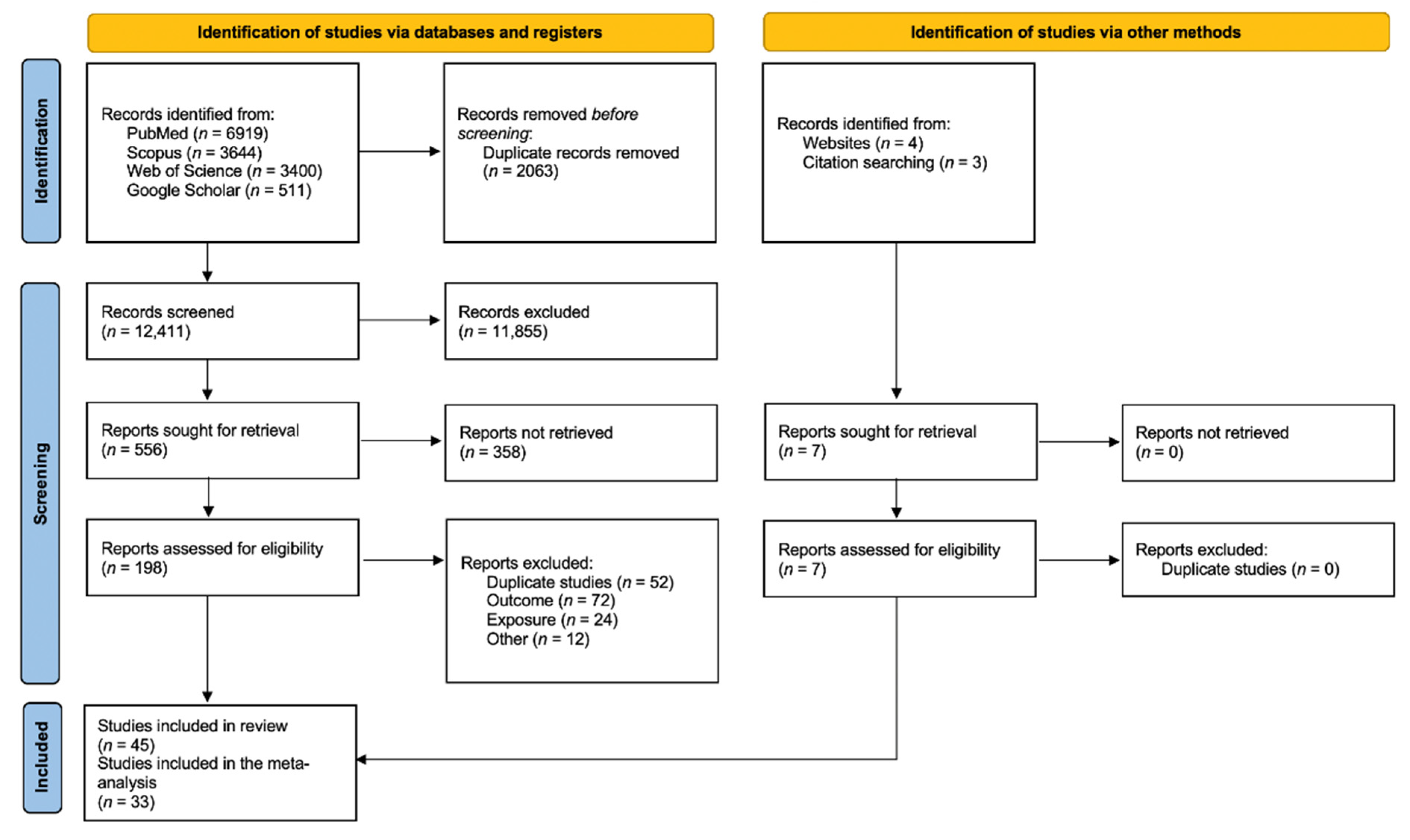
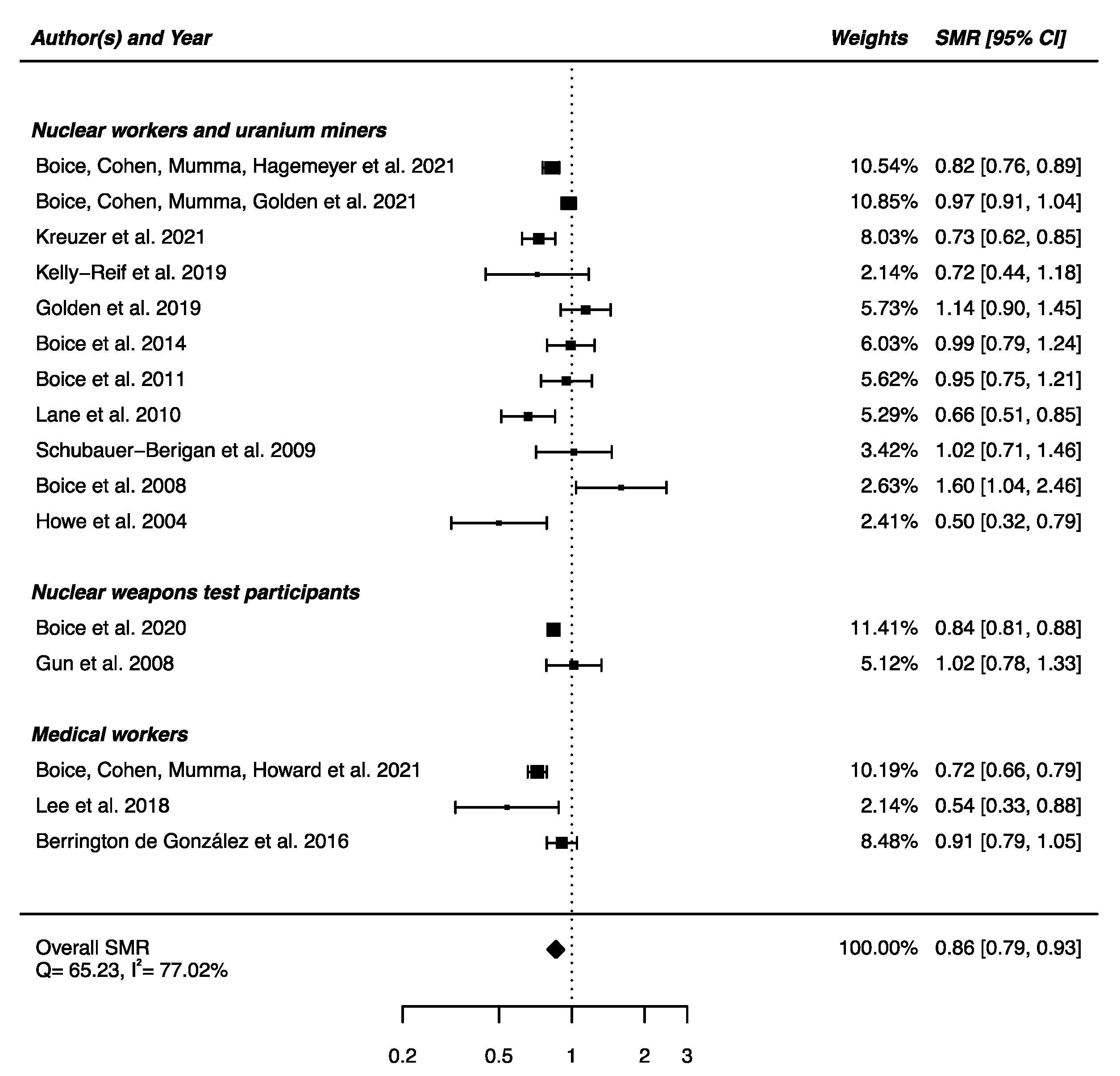
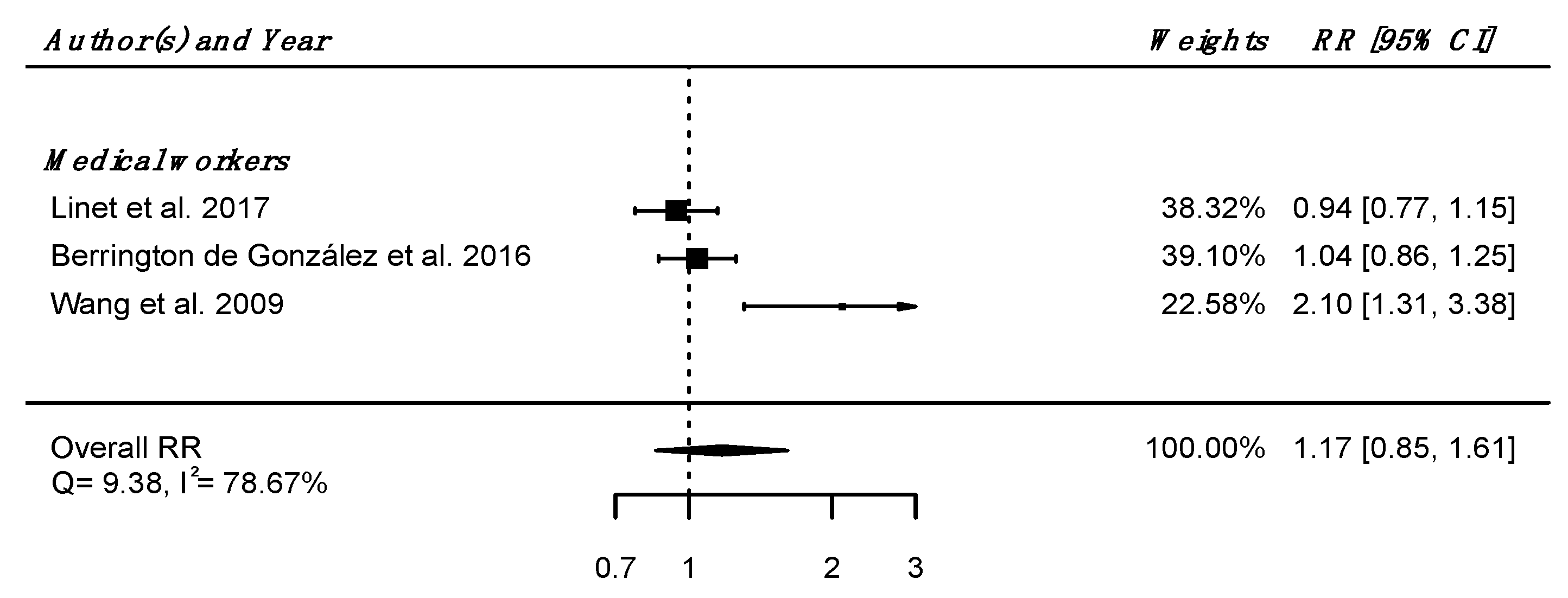
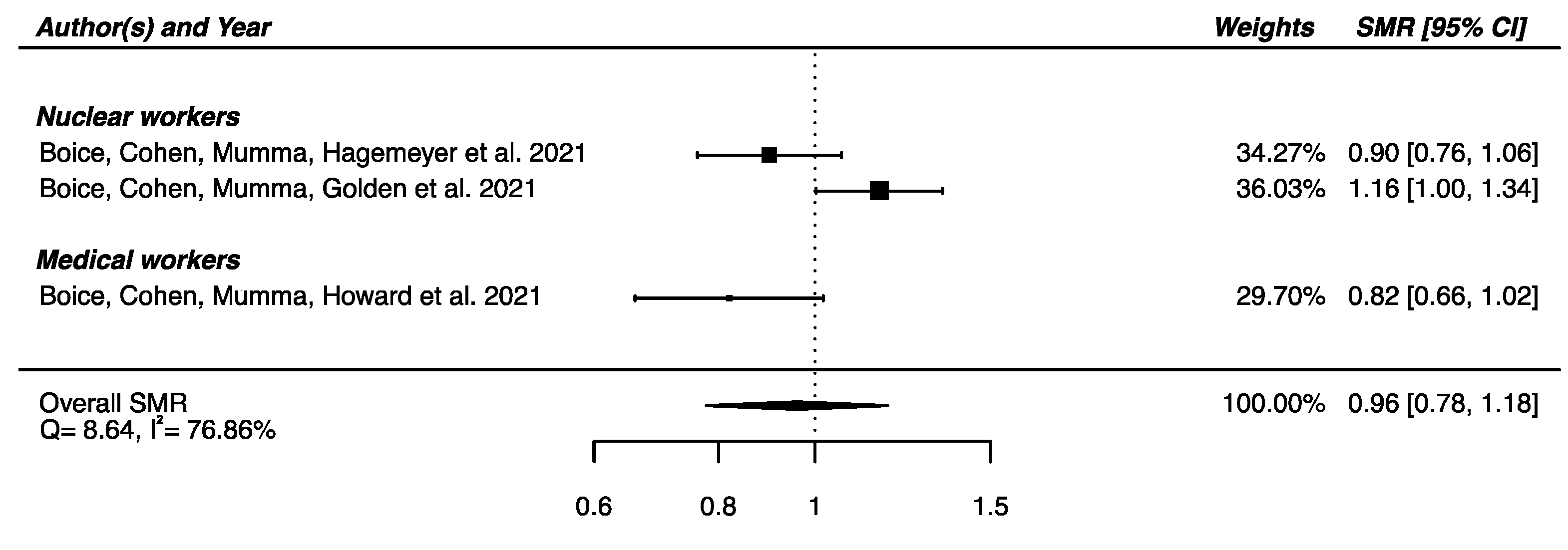
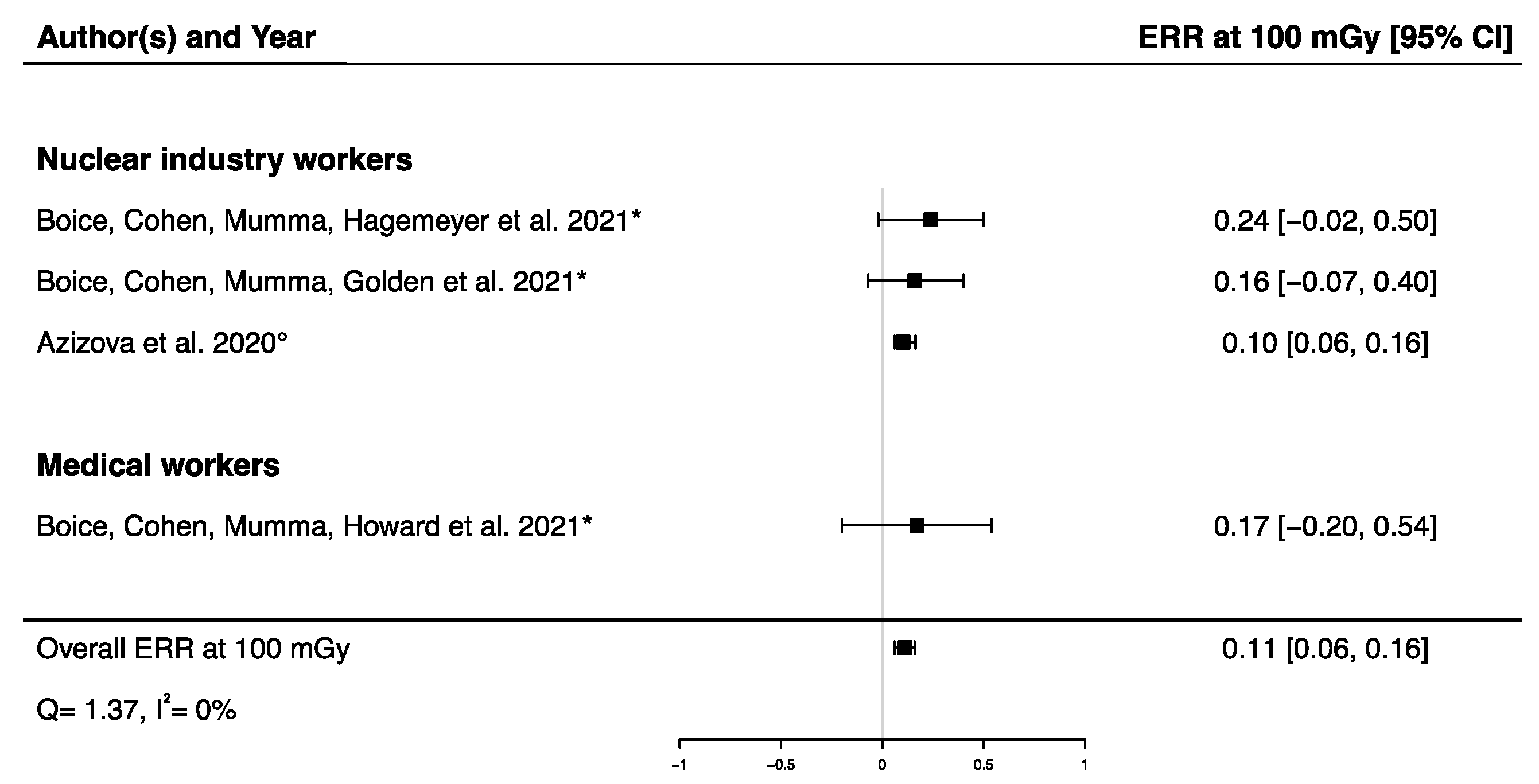
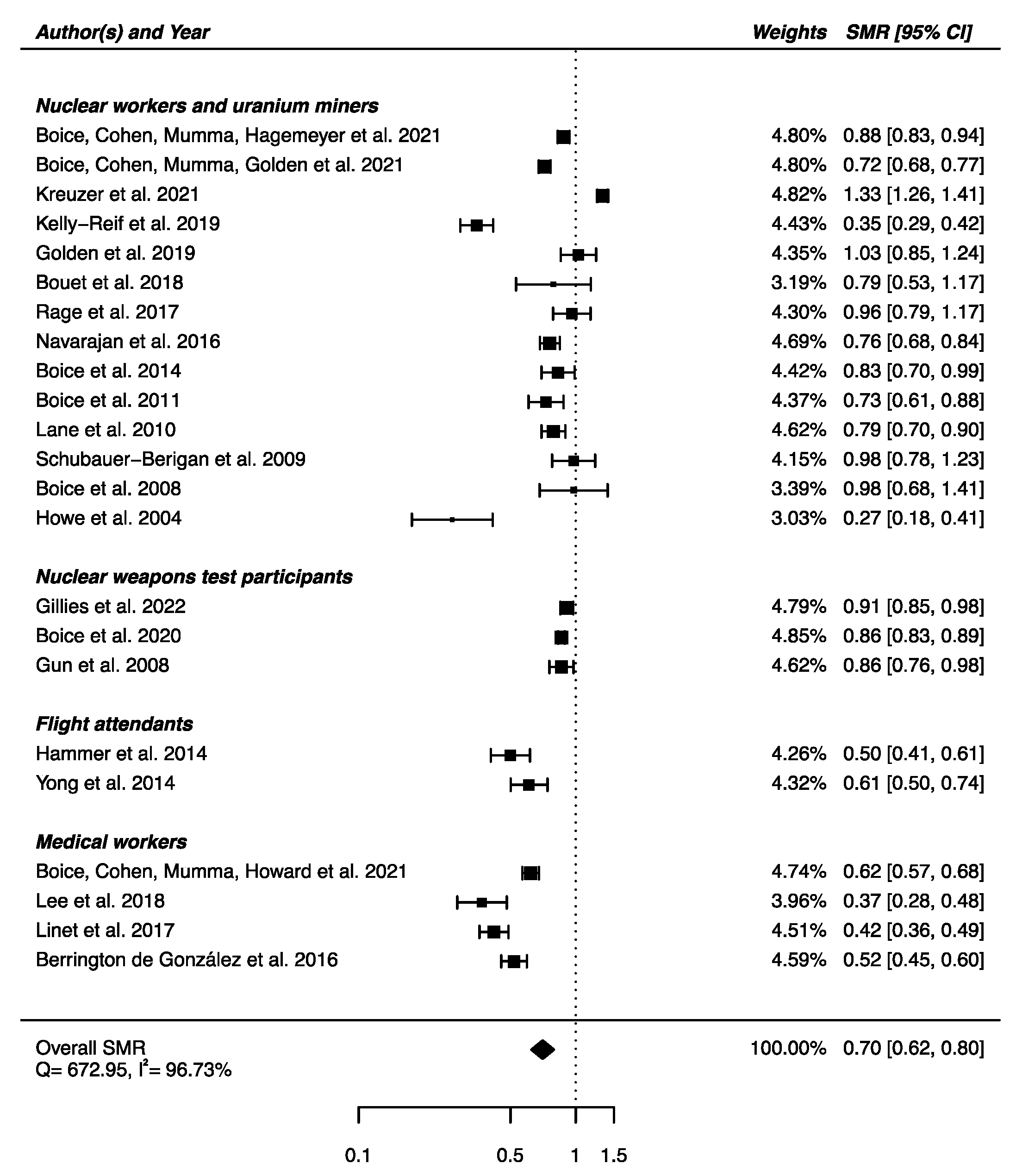
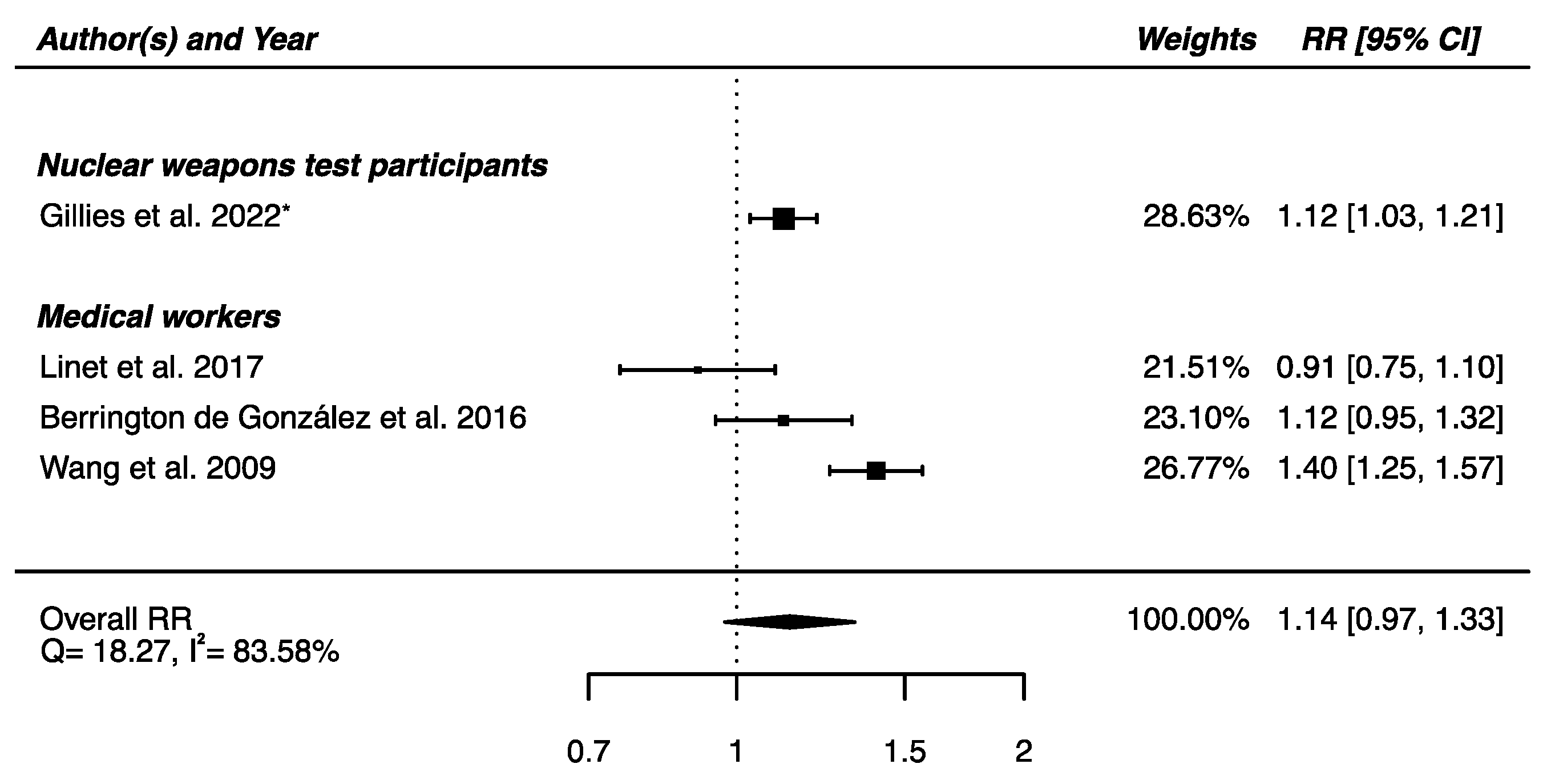
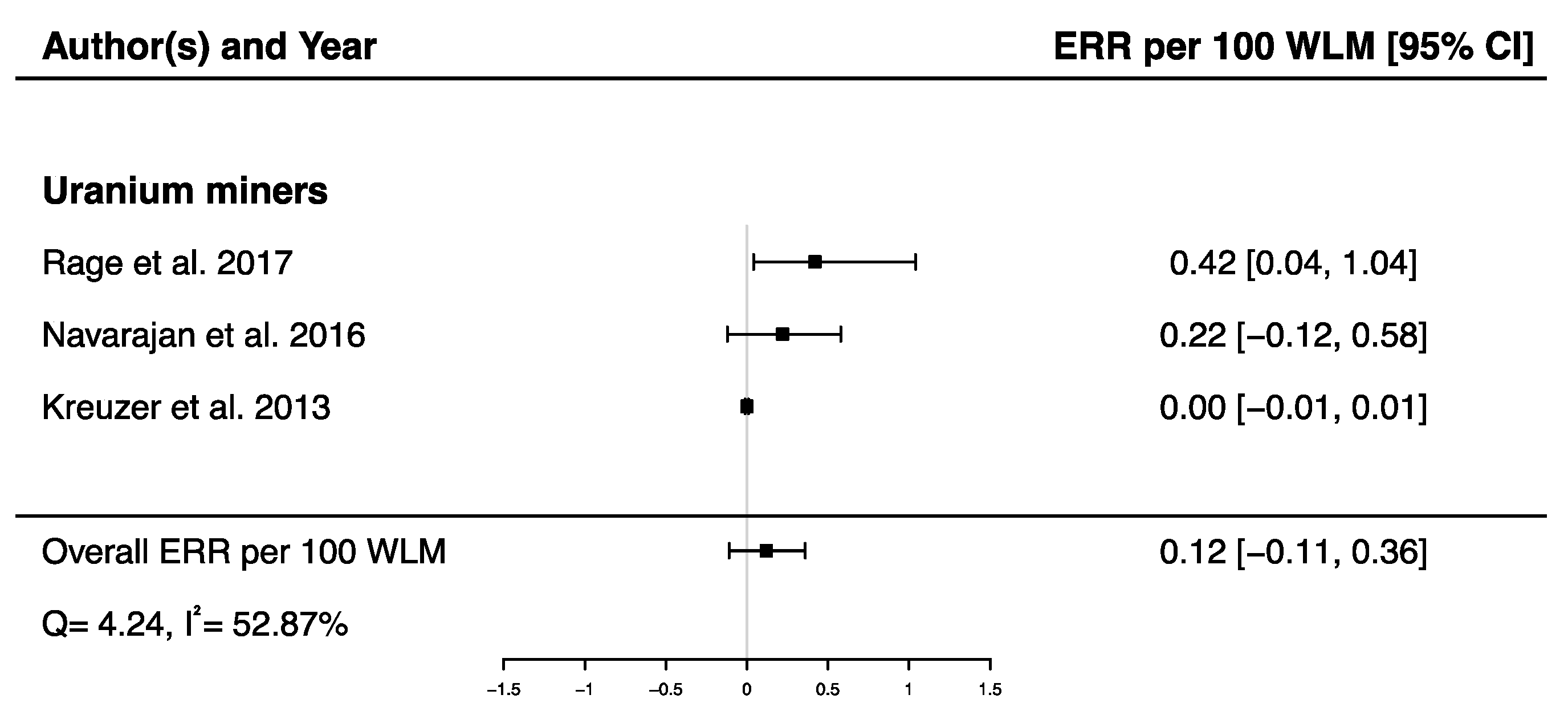
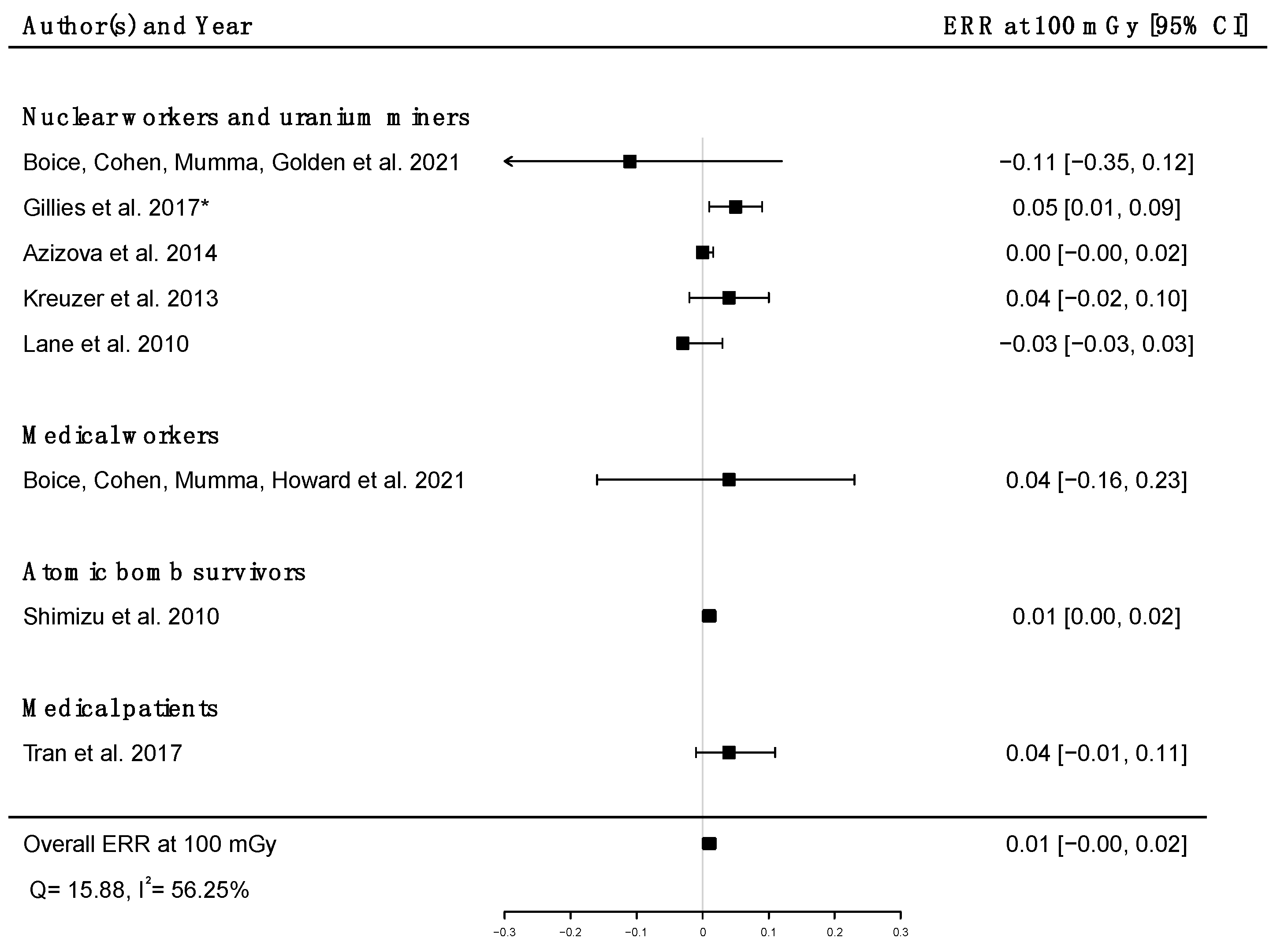
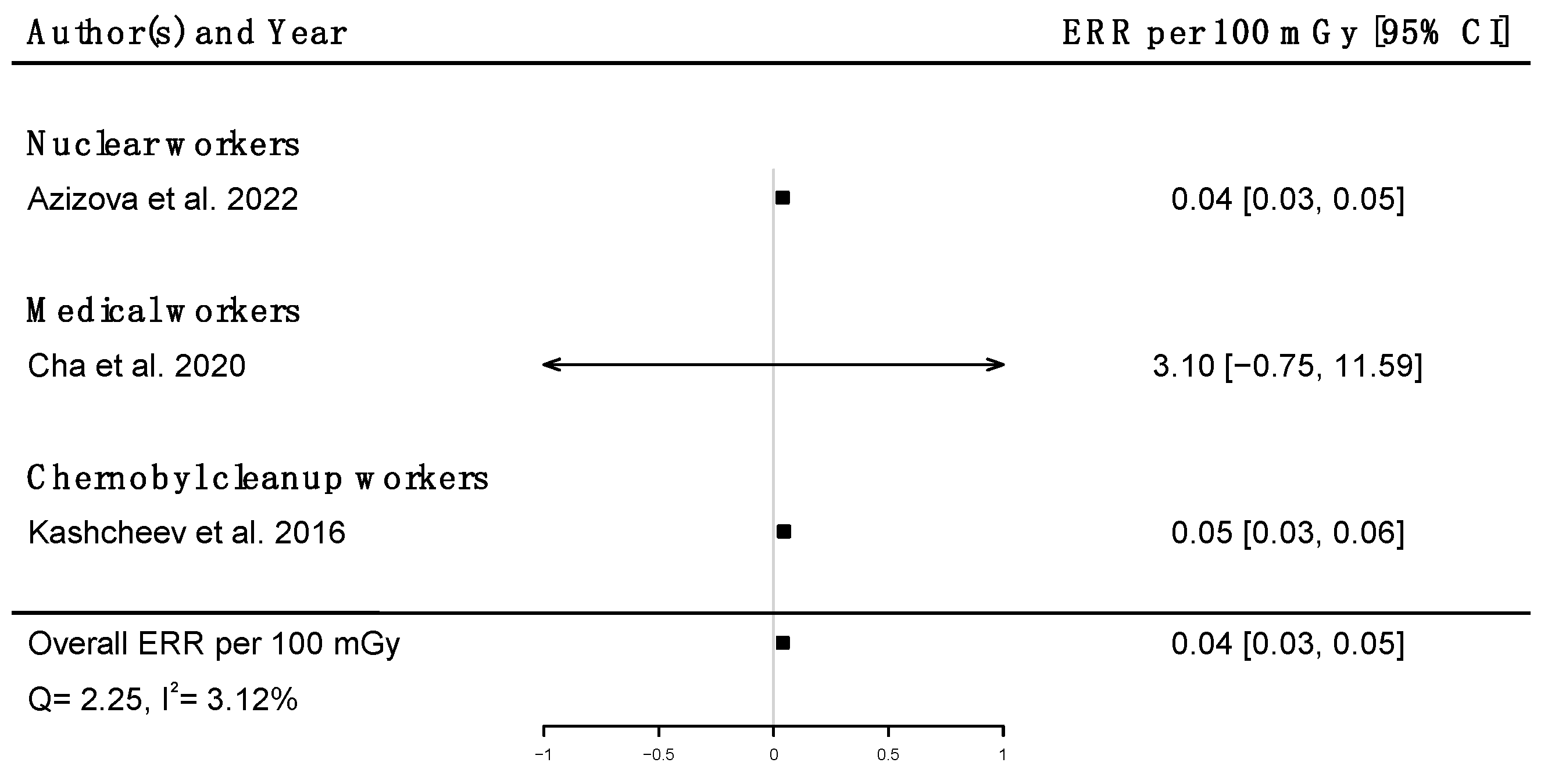
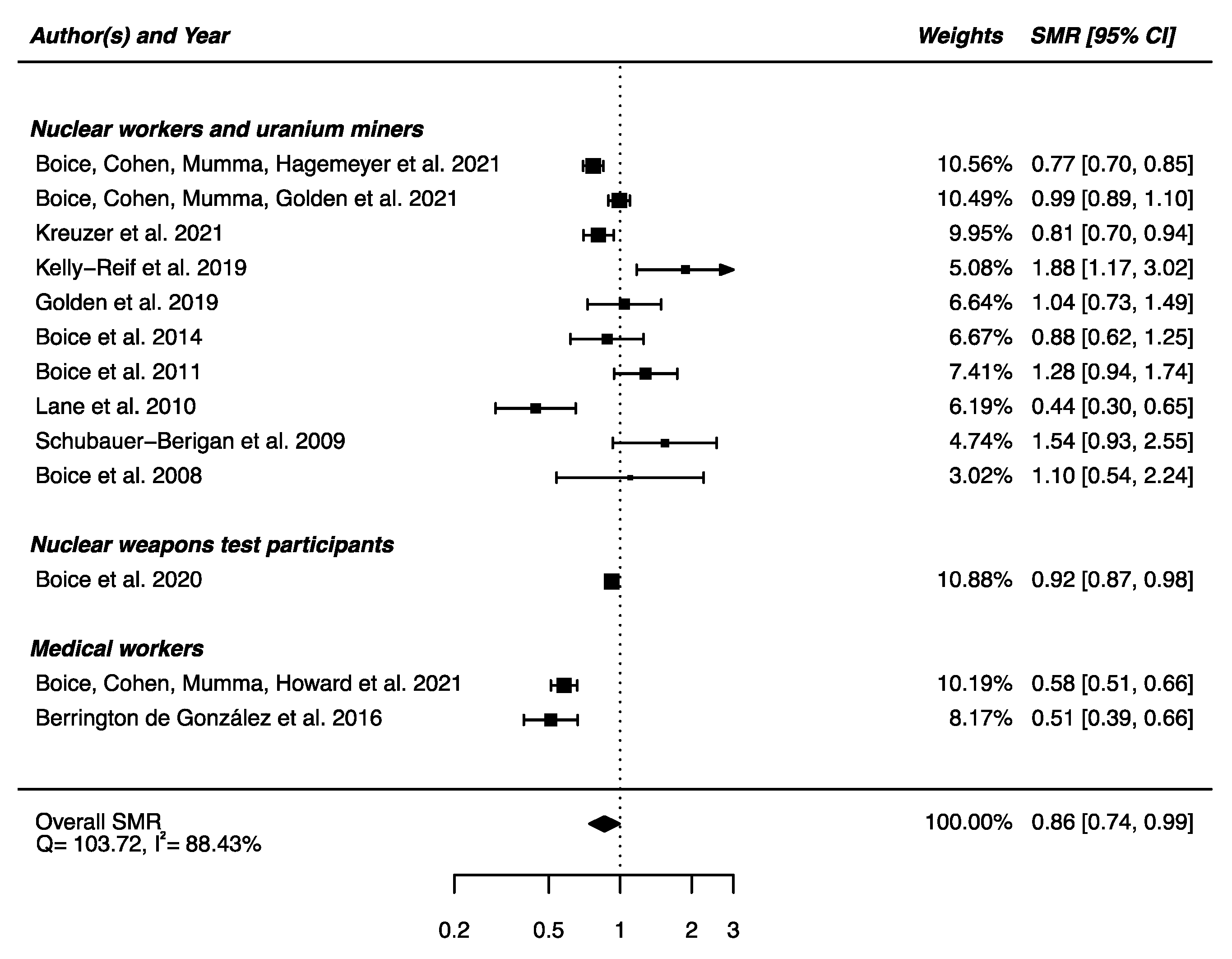
| First Author, Year | Country | Design | Population | Exposure Assessment | NOS Scores |
|---|---|---|---|---|---|
| Nuclear workers and uranium miners | |||||
| Azizova et al., 2022 [30] | Russia | Cohort | 22,377 Russia Mayak nuclear workers (M/F) | Mean cumulative liver absorbed dose of gamma rays from external exposure: 0.45 (SD: 0.65) Gy (M), 0.37 (SD: 0.56) Gy (F) Mean alpha activity: 1.20 (SD: 4.42) kBq (M), 1.83 (SD: 10.03) kBq (F) Mean cumulative liver-absorbed doses of alpha particles from internal exposure: 0.18 (SD: 0.65) Gy (M), 0.40 (SD: 1.92) Gy (F) | 8 |
| Hinksman et al., 2022 [31] | U.K. | Cohort | 150,390 (M), 16,422 (F) radiation workers | Median dose (IQR): 3.1 (0.3, 16.0) mSv | 8 |
| Boice, Cohen, Mumma, Hagemeyer et al., 2021 [32] | USA | Cohort | 130,773 (M), 4420 (F) nuclear power plant workers | Mean dose to the brain: 33.2 mGy (max: 0.83 Gy) | 8 |
| Boice, Cohen, Mumma, Golden et al., 2021 [33] | USA | Cohort | 19,808 (M), 6520 (F) workers at the Los Alamos National Laboratory | Brain radiation absorbed dose, combining external and internal sources for Pu: mean: 11.6 mGy; median: 0.76 mGy; max: 760 mGy | 8 |
| Kreuzer et al., 2021 [34] | Germany | Cohort | 35,204 (M) underground miners | Mean cumulative exposure to radon: 364 WLM and silica dust: 7.6 mg/m3 -years | 8 |
| Azizova et al., 2020 [12] | Russia | Cohort | 16,688 (M), 5689 (F) Mayak workers | Mean cumulative dose from external gamma-rays absorbed in the brain: 0.46 ± 0.67 (95th percentile: 1.55 Gy, min-max: 0.00–8.01 Gy) (M), 0.36 ± 0.56 Gy (95th percentile: 1.55, min-max: 0.00–6.14 Gy) (F) | 9 |
| Kelly-Reif et al., 2019 [35] | Czech Republic | Cohort | 16,434 (M) underground uranium miners | NA | 7 |
| Golden et al., 2019 [36] | USA | Cohort | 2514 (M) Mallinckrodt uranium processing workers | Mean brain dose from all sources of external and internal radiation combined: 37.2 mGy (max: 750 mGy) | 8 |
| Bouet et al., 2018 [37] | France | Cohort | 1180 (M), 111 (F) uranium millers | NA | 7 |
| Rage et al., 2017 [38] | France | Cohort | 5400 (M) uranium miners | Cumulative exposure (WLM), mean (se): 35.1 (69.9), median (min-max): 10.8 (0.002–960.1) | 7 |
| Gillies et al., 2017 [39] | France, U.K. and USA | Joint analysis cohorts | 308,297 (M/F) nuclear workers | Average cumulative dose: 25.2 mSv, collective dose: 7771.5 Sv, median dose: 3.4 mSv, 90th percentile dose: 64.5 mSv, max dose: 1932 mSv | 8 |
| Navaranjan et al., 2016 [40] | Canada | Cohort | 28,546 (M), 413 (F) uranium miners | Mean cumulative exposure: 21.0 WLM, range: 0.0–875.1 WLM (M) and 0.2 WLM, range: 0.0–16.3 WLM (F) | 8 |
| Azizova et al., 2014 [41] | Russia | Cohort | 16,688 (M), 5689 (F) Mayak workers | Mean (±SD) total dose from external gamma rays: 0.54 ± 0.76 Gy (95% percentile 2.21 Gy) (M) and 0.44 ± 0.65 Gy (95% percentile 1.87 Gy) (F). Mean plutonium body burden: 1.32 ± 4.87 kBq (95% percentile 4.71 kBq) (M) and 2.21 ± 13.24 kBq (95% percentile 4.56 kBq) (F). Mean total absorbed alpha-particles dose to the liver from incorporated plutonium: 0.23 ± 0.77 Gy (95% percentile 0.89 Gy) (M) and 0.44 ± 2.11 Gy (95% percentile 1.25 Gy) (F) | 7 |
| Boice et al., 2014 [42] | USA | Cohort | 4004 (M), 973 (F) mound workers | Mean dose from external radiation: 26.1 mSv (max: 939.1 mSv). Mean lung dose from internal exposure: 100.1 mSv (max: 17.5 Sv). Mean liver dose from external and internal radiation: 34.6 mSv (max: 2.3 Sv) | 7 |
| Kreuzer et al., 2013 [43] | Germany | Cohort | 58,982 (M) uranium miners (WISMUT cohort) | Mean cumulative gamma dose: 47 mSv (max: 909 mSv) Mean cumulative exposure to radon progeny or long-lived radionuclides: 280 WLM (max = 3224) and 4.1 kBqh/m3 (max = 132), respectively | 8 |
| Boice et al., 2011 [44] | USA | Cohort | 5335 (M), 466 (F) radiation workers at Rocketdyne | Mean dose from external radiation: 13.5 mSv (max: 1 Sv) and the mean lung dose from external and internal radiation combined: 19.0 mSv (max: 3.6 Sv) | 7 |
| Lane et al., 2010 [45] | USA | Cohort | 16,236 (M) and 1424 (F) uranium workers (Eldorado cohort) | Mean radon decay products exposure (SD): 100.2 WLM (254.4 WLM) (M), 4.6 WLM (10.1 WLM) (F); mean gamma-ray dose (SD): 52.2 mSv (152.4 mSv) (M), 34.4 mSv (77.4 mSv) (F) | 8 |
| Schubauer-Berigan et al., 2009 [46] | USA | Cohort | 3358 white uranium miners (M) and 779 uranium miners of another race (M) (Colorado Plateau Cohort) | Cumulative radon exposure: from uranium mining: mean (SD): 806 WLM (1130 WLM); median (interdecile interval): 426 WLM (44.1–2070 WLM) for whites and mean (SD): 742 WLM (840 WLM); median (interdecile interval): 392 WLM (43.7–2010 WLM) for American Indians and including hard rock mines: mean (SD): 824 WLM (1140 WLM); median (interdecile interval): 439 WLM (55.0–2080 WLM) for whites and mean (SD): 742 WLM (840 WLM); median (interdecile interval): 392 WLM (43.7–2030 WLM) for American Indians | 8 |
| Boice et al., 2008 [47] | USA | Cohort | 2500 (M), 245 (F) uranium millers and miners | NA | 7 |
| Villeneuve et al., 2007 [48] | Germany | Cohort | 2070 (M) miners (Newfoundland fluorspar cohort) | Mean annual radon exposure among the underground miners: 43.6 WLM/year | 8 |
| Howe et al., 2004 [49] | USA | Cohort | 47,311 (M), 6387 (F) nuclear power industry workers | Mean cumulative dose: 28.5 mSv (M), 4.6 mSv (F) and 25.7 mSv for the all cohort | 7 |
| Sibley et al., 2003 [50] | USA | Case-control | 91 cases and 910 controls (F) nuclear weapons workers | 14 cases and 154 controls monitored for radiation. Max annual radiation dose: 49.9 mSv | 6 |
| Atomic bomb survivors | |||||
| Shimizu et al., 2010 [51] | Japan | Cohort | 35,687 (M), 50,924 (F) Hiroshima and Nagasaki atomic bomb survivors (Life Span Study cohort) | Individual estimate radiation doses ranged from 0 to >3 Gy (86% of the cohort members received <0.2 Gy) | 8 |
| Nuclear weapons test participants | |||||
| Gillies et al., 2022 [52] | U.K. | Cohort | 21,357 servicemen and male civilians from the U.K. who participated in the U.K.’s atmospheric nuclear weapon tests and experimental programs and a group of 22,312 controls | 8% of the total participant cohort had non-zero recorded radiation doses and the mean dose from gamma radiation amongst these men was 9.9 mSv | 7 |
| Boice et al., 2020 [53] | USA | Cohort | 114,270 (M) military participants at eight aboveground nuclear weapons test series | Mean NuTRIS film badge gamma radiation dose: 6 mSv (max: 908 mSv) | 8 |
| Gun et al., 2008 [54] | Australia | Cohort | 10,983 (M) participants in the British nuclear tests in Australia | Total (collective) dose was approximately 31 Sv | 8 |
| Flight attendants | |||||
| Hammer et al., 2014 [55] | 10 Countries | Joint analysis of cohorts | 12,288 (M), 44,667 (F) cabin crew and 36,816 (M) cockpit crew | NA | 7 |
| Yong et al., 2014 [56] | U.S.A. | Cohort | 5958 (M), 6 (F) commercial airline cockpit crew | Mean annual cosmic radiation dose: 1.4 mSv (median: 1.4 mSv, range: 0.0042–2.8 mSv) | 8 |
| Environmental exposure | |||||
| Kim et al., 2020 [57] | South Korea | Cross-sectional study | 12,154 (M), 16,403 (F) study participants | Radon exposure: 103.1 ± 22.0 Bq/m3 | 8 |
| Medical workers | |||||
| Boice, Cohen, Mumma, Howard et al., 2021 [58] | USA | Cohort | 55,218 (M), 53,801 (F) medical and associated radiation workers | Mean (max) cumulative absorbed dose to the brain: 18.9 mGy (1.08 Gy) | 8 |
| Cha et al., 2020 [59] | South Korea | Cohort | 7827 (M), 3673 (F) medical radiation workers | Mean cumulative badge dose: 7.20 mSv. Mean cumulative heart dose: 6.2 mGy (range: 0.002–72.9 mGy) | 8 |
| Lee et al., 2018 [60] | South Korea | Cohort | 80,837 (M/F) diagnostic medical radiation workers | NA | 7 |
| Linet et al., 2017 [61] | USA | Cohort | Physicians likely to perform fluoroscopy guided interventional procedures (n = 41,486 (M), n = 4148 (F). Psychiatrists (n = 46,846 (M), 17,555 (F)) | NA | 7 |
| Berrington de González et al., 2016 [62] | USA | Cohort | Radiologists (n = 34, 912 (M), n = 8851 (F)). Psychiatrists (n = 47,497 (M), n = 17,493 (F)) | NA | 7 |
| Rajaraman et al., 2016 [63] | USA | Cohort | 65,131 (M), 19,835 (F) radiologic technologists (U.S. Radiologic Technologists cohort) | NA | 8 |
| Wang et al., 2009 [64] | China | Cohort | 21,586 (M), 5443 (F) medical diagnostic X-ray workers compared to 17,694 (M), 8088 (F) other medical specialists | Average radiation exposure for the workers employed until 1969: 551 mGy; employed between 1970 and 1980: 82 mGy | 7 |
| Chernobyl cleanup workers | |||||
| Loganovsky et al., 2020 [65] | Ukraine | Cohort and cross-sectional study | 198 Chernobyl clean-up workers compared to 110 men. Internal comparison group: 42 clean-up workers irradiated at dose 0.6–50.0 mSv | Average dose of the external exposure of the examined clean-up workers: 456.0 mSv (SD: 760.0 mSv), range: 0.6–5900.0 mSv | 6 |
| Buzunov et al., 2018 [66] | Ukraine | Cohort | 18,133 (M), 24,849 (F) evacuees from the Chernobyl zone | Personnel data on radiation dose are available for: 957 people. Dose intervals: 0–0.3 Gy, 0.31–0.75 Gy, 0.76–2.0 Gy, above 2 Gy | 6 |
| Kashcheev et al., 2016 [67] | Russia | Cohort | 53,772 (M) recovery operation workers of the Chernobyl accident | Mean external whole body dose: 0.161 Gy (max: 1.42 Gy) | 7 |
| Loganovsky et al., 2016 [68] | Ukraine | Cohort | 196 men examined before (t0) and after (t1) working on the Shelter Object (SO) | In the observational period, the SO staff were exposed to external irradiation at the dose range of 0–54.3 mSv (mean ± SD: 19.5 ± 12.8 mSv), to internal irradiation at the dose range of 0–2.4 mSv (mean ± SD: 0.4 ± 0.5 mSv), and to total irradiation at the dose range of 0–56.7 mSv (mean ± SD: 19.9 ± 13.0 mSv) | 5 |
| Bazyka et al., 2015 [69] | Ukraine | Cohort | 326 Chernobyl cleanup workers, 290 of which had doses under 500 mSv. Internal control group: 44 other workers exposed to doses less than 20 mSv. | Radiation dose values ranged from 0.8 mSv to 2800 mSv (274.0 ± 418.9 mSv) (mean ± SD) | 6 |
| Rahu et al., 2014 [70] | Estonia | Cohort | 3680 exposed cleanup workers from Estonia compared to an unexposed cohort of 7631 men | Mean and median radiation doses: 9.9 and 8.9 cGy respectively (range: 0.0–54.5 cGy) | 7 |
| Loganovsky et al., 2013 [71] | Ukraine | Cross-sectional study | 241 people, 219 of whom have been diagnosed with PTSD: 115 cleanup workers of the Chernobyl accident (34 with ARS), 76 evacuees from the Chernobyl exclusion zone. Comparison group: 28 veterans of the war of Afghanistan. Control group: 22 healthy unexposed individuals. | Cleanup workers without ARS: dose range of 3.1–856.0 mSv (mean ± SD: 247.2 ± 224.1 mSv) Cleanup workers with ARS: dose range of 0.1–7.1 Gy (mean ± SD: 2.0 ± 1.9 Gy). | 5 |
| Loganovsky et al., 2000 [72] | Ukraine | Cross-sectional study | 100 patients with ARS and 100 liquidators compared with a control group (n = 20) and with veterans of the Afghanistan war with PTSD (n = 50) and veterans with both PTSD and closed head injury (n = 50) | 100 patients with ARS: absorbed doses up to 6.6 Gy 54 of the 100 liquidators were chronically irradiated at doses below 0.30 Sv (average dose: 0.16 ± 0.05 Sv) and the 46 left were chronically irradiated above 0.30 Sv (average dose: 0.69 ± 0.15 Sv) | 4 |
| Medical patients | |||||
| Tran et al., 2017 [73] | Canada and USA | Pooled cohort | 28,229 (F), 30,447 (M) patients | Mean cumulative lung dose: 0.18 Gy (range: 0.01–0.50) | 7 |
| First Author, Year | Outcomes(s) | Major Results | Confounding Factors Included in ERR Models |
|---|---|---|---|
| Nuclear workers and uranium miners | |||
| Boice, Cohen, Mumma, Hagemeyer et al., 2021 [32] | 1—Dementia and Alzheimer’s disease (ICD-9: 290.0–290.4, 331.0) 2—Dementia, Alzheimer’s, Parkinson’s, and other motor neuron diseases (ICD-9: 290.0–290.4, 331.0, 332, 335.2) 3—Diseases of the nervous system and sense organs (ICD-9: 320–389) 4—Parkinson’s disease (ICD-9: 332) | 1—SMR (95% CI): 0.92 (0.84, 1.02), ndeaths = 411 2—SMR (95% CI): 0.93 (0.86, 1.00), ndeaths = 657 3—SMR (95% CI): 0.82 (0.76, 0.89), ndeaths = 673 4—SMR (95% CI): 0.90 (0.76, 1.06), ndeaths = 140; HR (95% CI) at 100 mGy: 1.27 (0.98, 1.65); ERR (95% CI) at 100 mGy: 0.24 (−0.02, 0.50) | Sex, year of birth, SES, with a 10-year lag |
| Boice, Cohen, Mumma, Golden et al., 2021 [33] | 1—Dementia and Alzheimer’s disease (ICD-9: 290.0–290.4, 331.0) 2—Dementia, Alzheimer’s, Parkinson’s, and other motor neuron diseases (ICD-9: 290.0–290.4, 331.0, 332, 335.2) 3—Diseases of the nervous system and sense organs (ICD-9: 320–389) 4—Parkinson’s disease (ICD-9: 332) | 1—SMR (95% CI): 0.92 (0.85, 0.98), ndeaths = 735 2—SMR (95% CI): 0.96 (0.90, 1.02), ndeaths = 973; HR (95% CI) at 100 mGy: 0.99 (0.83, 1.18); ERR (95% CI) at 100 mGy: −0.01 (−0.19, 0.16) 3—SMR (95% CI): 0.97 (0.90, 1.03), ndeaths = 815 4—SMR (95% CI): 1.16 (1.00, 1.34), ndeaths = 193; HR (95% CI) at 100 mGy: 1.18 (0.93, 1.49); ERR (95% CI) at 100 mGy: 0.16 (−0.07, 0.40) | Sex, year of birth, education, with a 10-year lag |
| Kreuzer et al., 2021 [34] | 1—Diseases of the nervous system (ICD-10: G00–G99) 2—Amyotrophic lateral sclerosis (ICD-10: G12.2) | 1—SMR (95% CI): 0.73 (0.62, 0.85), ndeaths = 163 2—SMR (95% CI): 1.10 (0.67, 1.70) ndeaths = 20 | |
| Azizova et al., 2020 [12] | Incidence from Parkinson’s disease (ICD-10: G20) | ERR (95% CI) per Gy = 1.03 (95% CI: 0.60, 1.64), ndiseases = 300 | Sex, attained age, with a 10-year lag |
| Kelly-Reif et al., 2019 [35] | Diseases of the nervous system and sense organs (ICD-9: 320–389) | SMR (95% CI): 0.72 (0.39, 1.04), ndeaths = 19 | |
| Golden et al., 2019 [36] | 1—Disease of the nervous system and sense organs (ICD-9: 320–389) 2—Dementia and Alzheimer’s disease (ICD-9: 290, 331) 3—Dementia, Alzheimer’s, Parkinson’s and motor neuron diseases (290, 331, 332, 335.2) | 1—SMR (95% CI): 1.14 (0.89, 1.43), ndeaths = 72 2—SMR (95% CI): 1.18 (0.88, 1.55), ndeaths = 50 3—SMR (95% CI): 1.17 (0.91, 1.48) ndeaths = 71; HR (95% CI) at 100 mGy: 0.91 (0.64, 1.29); ERR (95% CI) at 100 mGy: −0.13 (−0.28, 0.02) | Year of birth and pay-type (hourly vs. salary) |
| Gillies et al., 2017 [39] | Mortality from disease of the nervous system and sense organs (ICD-9: 320–389/ICD-10: G00-H95) | ERR (90% CI) per Sv: −0.15 (<−0.68, 0.50), ndeaths = 1505 | Age, birth-cohort, gender, socioeconomic status, duration of employment, facility of employment, with a 10-year lag |
| Boice et al., 2014 [42] | Diseases of the nervous system and sense organs (ICD-9: 320–389) | SMR (95% CI) 0.99 (0.79, 1.24), ndeaths = 78 | |
| Boice et al., 2011 [44] | Diseases of the nervous system and sense organs (ICD-9: 320–389) | SMR (95% CI): 0.95 (0.74, 1.20), ndeaths = 71 | |
| Lane et al., 2010 [45] | All nervous system diseases (ICD-NA) | SMR (95% CI): 0.66 (0.51, 0.85), ndeaths = 61 | |
| Schubauer-Berigan et al., 2009 [46] | Nervous system disorders (ICD-NA) | Whites: SMR (95% CI): 1.02 (0.70, 1.44), ndeaths = 32 American Indians: SMR (95% CI): 1.32 (0.63, 2.43), ndeaths = 10 | |
| Boice et al., 2008 [47] | Diseases of the nervous system and sense organs (ICD-9: 320–389) | SMR (95% CI): 1.60 (1.01, 2.39) (M/F), ndeaths = 23; SMR (95% CI): 1.52 (0.94, 2.32) (M), ndeaths = 21; SMR (95% CI): 3.29 (0.40, 11.9), ndeaths = 2 (F) | |
| Howe et al., 2004 [49] | Nervous system disease (ICD: NA) | SMR (95% CI): 0.50 (0.31, 0.77), ndeaths = 20 RR (95% CI): dose group: <1 mSv: 1.00 (ref); 1–49 mSv: 1.08 (0.33, 3.54); 100-mSv: 3.25 (0.52, 20.29) ERR (95% CI) per Sv: 46.8 (1.51, 242) | Sex, age, calendar year, ethnicity, SES, facility, duration of monitoring, with a 10-year lag |
| Nuclear weapons test participants | |||
| Boice et al., 2020 [53] | 1—Diseases of nervous system and sense organs (ICD-9: 320–389) 2—Dementia and Alzheimer’s disease (ICD-9: 290.0–290.4, 331.0) | 1—SMR (95% CI): 0.84 (0.81, 0.88), ndeaths = 1871 2—SMR (95% CI): 0.90 (0.86, 0.95), ndeaths = 1330 | |
| Gun et al., 2008 [54] | 1—Nervous system disease (ICD: NA) 2—Motor neuron disease (ICD: NA) | 1—SMR (95% CI): 1.02 (0.78, 1.32), ndeaths = 59 2—SMR (95% CI): 1.24 (0.71, 2.02), ndeaths = 16 | |
| Medical workers | |||
| Boice, Cohen, Mumma, Howard et al., 2021 [58] | 1—Diseases of the nervous system and sense organs (ICD-9: 320–389) 2—Parkinson’s disease (ICD-9: 332) 3—Dementia and Alzheimer’s disease (ICD-9: 290.0–290.4, 331.0) 4—Dementia, Alzheimer’s, Parkinson’s, and other motor neuron diseases (ICD-9: 290.0–290.4, 331.0, 332, 335.2) | 1—SMR (95% CI): 0.72 (0.65, 0.78), ndeaths = 471 2—SMR (95% CI): 0.82 (0.66, 1.02), ndeaths = 84; HR (95% CI) at 100 mGy: 1.18 (0.82, 1.71); ERR (95% CI) at 100 mGy: 0.17 (−0.20, 0.54) 3—SMR (95% CI): 0.70 (0.63, 0.79), ndeaths = 326 4—SMR (95% CI): 0.74 (0.68, 0.81), ndeaths = 476; HR (95% CI) at 100 mGy: 1.05 (0.88, 1.25); ERR (95% CI): 0.05 (−0.13, 0.23) | Sex, year of birth, occupational category, with a 10-year lag |
| Lee et al., 2018 [60] | Diseases of the nervous system (ICD-10: G00–G99) | SMR (95% CI): 0.54 (0.33, 0.88), ndeaths = 16 (M) | |
| Linet et al., 2017 [61] | Neurological and mental conditions (ICD: NA) | RR (95% CI): 0.94 (0.77, 1.15) | |
| Berrington de González et al., 2016 [62] | 1—Diseases of the nervous system (ICD-9: 320–389/ICD-10: G00–G99) 2—Other degenerative diseases of the nervous system (ICD-9: 331.1–337.9/ICD-10: G31–G32) 3—Alzheimer disease (ICD-9: 331.0/ICD-10: G30) | 1—RR (95% CI): 1.04 (0.86, 1.25) 1—SMR (95% CI): 0.91 (0.78, 1.04) (M/F), ndeaths = 185 2—RR (95% CI): 1.39 (0.96, 2.01) 2—SMR (95% CI): 1.50 (1.09, 1.90) (M/F), ndeaths = 53 3—RR (95% CI): 0.94 (0.67, 1.33) 3—SMR (95% CI): 0.91 (0.66, 1.16) (M/F), ndeaths = 51 | |
| Wang et al., 2009 [64] | Diseases of the nervous system and sense organs (ICD-9: 320–386) | RR (95% CI): 2.10 (1.20, 3.10) | |
| Chernobyl cleanup workers | |||
| Rahu et al., 2014 [70] | 1—Disease of the nervous system (ICD-10: G00–G99) 2—Degeneration of nervous system due to alcohol (ICD-10: G31.2) 3—Epilepsy (ICD-10: G40) 4—Migraine and other headache (ICD-10: G43–G44) 5—Nerve, nerve root and plexus disorders (ICD-10: G50–G59) 6—Sleep disorders (ICD-10: F51, G47) | 1—RR (95% CI): 1.13 (1.06, 1.21) 2—RR (95% CI): 1.51 (1.04, 2.18) 3—RR (95% CI): 1.40 (1.14, 1.73) 4—RR (95% CI): 1.03 (0.83, 1.28) 5—RR (95% CI): 1.15 (1.02, 1.29) 6—RR (95% CI): 1.08 (0.93, 1.25) | |
| First Author, Year | Outcomes(s) | Major Results | Confounding Factors Included in ERR Models |
|---|---|---|---|
| Nuclear workers and uranium miners | |||
| Azizova et al., 2022 [30] | Incidence from cerebrovascular diseases (ICD-10: I60–I69) | External exposure: ERR (95% CI) per Gy: 0.39 (0.31, 0.48) (M/F); 0.37 (0.27, 0.47) (M); 0.47 (0.31, 0.66) (F) Internal exposure: ERR (95% CI) per Gy: 0.32 (0.16, 0.51) (M/F); 0.31 (0.10, 0.59) (M); 0.32 (0.11, 0.61) (F) | Sex, attained age, calendar period, smoking status, alcohol consumption status, gamma/alpha doses, with a 10-year lag |
| Hinksman et al., 2022 [31] | Mortality from cerebrovascular diseases (ICD-9: 430.0–438.9) | ERR (95% CI) per Sv: 0.57 (0.00, 1.31), ndeaths= 3219; SMR (95% CI): 0.87 (0.84, 0.90), ndeaths = 3219 | Calendar period, attained age, sex, employment length, first employer, industrial category, with a 10-year lag |
| Boice, Cohen, Mumma, Hagemeyer et al., 2021 [32] | Cerebrovascular diseases (ICD-9: 430–438) | SMR (95% CI): 0.88 (0.83, 0.94), ndeaths = 1078 | |
| Boice, Cohen, Mumma, Golden et al., 2021 [33] | Cerebrovascular diseases (ICD-9: 430–438) | SMR (95% CI): 0.72 (0.68, 0.77), ndeaths = 871; HR (95% CI) at 100 mGy: 0.89 (0.71, 1.13); ERR (95% CI) at 100 mGy: −0.11 (−0.35, 0.12) | Sex, year of birth, education, with a 10-year lag |
| Kreuzer et al., 2021 [34] | Cerebrovascular diseases (ICD-10: I60–I69) | SMR (95% CI): 1.33 (1.26, 1.41), ndeaths = 1335 | |
| Kelly-Reif et al., 2019 [35] | Cerebrovascular diseases (ICD-9: 430–438) | SMR (95% CI): 0.35 (0.29, 0.41), ndeaths = 148 | |
| Golden et al., 2019 [36] | Cerebrovascular diseases (ICD-9: 430–438) | SMR (95% CI): 1.03 (0.85, 1.24), ndeaths = 114 | |
| Bouet et al., 2018 [37] | Cerebrovascular diseases (ICD- 9: 430–438/ICD-10: I60–I69, G45 except G45.3 and G45.4, G46) | SMR (95% CI): 0.79 (0.52, 1.15), ndeaths = 27 | |
| Rage et al., 2017 [38] | Mortality from cerebrovascular diseases (ICD-10: I60–I69) | SMR (95% CI): 0.96 (0.78, 1.16), ndeaths = 105; ERR (95% CI) per 100 WLM: 0.42 (0.04, 1.04) | Unadjusted ERR model, with a 10-year lag. |
| Gillies et al., 2017 [39] | Mortality from cerebrovascular diseases (ICD-9: 430–438/ICD-10: I60–I69) | ERR per Sv (90% CI): 0.49 (0.11, 0.92), ndeaths = 4399 | Age, birth-cohort, gender, socioeconomic status, duration of employment, and facility of employment, with a 10-year lag |
| Navaranjan et al., 2016 [40] | Mortality from cerebrovascular diseases (ICD-9: 430–438) | SMR (95% CI): 0.76 (0.68, 0.84), ndeaths = 315; ERR (95% CI) per 100 WLM: 0.22 (−0.12, 0.58) | calendar period, attained age, with a 10-year lag |
| Azizova et al., 2014 [41] | Mortality from cerebrovascular diseases (ICD-9: 430–438) | RR (95% CI) by total whole body external gamma dose: <0.1 Gy: 1; 0.1–0.2 Gy: 0.89 (0.73, 1.09); 0.2–0.5 Gy: 0.89 (0.74, 1.07) ERR (95% CI) per Gy: 0.05 (−0.03, 0.16), ndeaths = 632 RR (95% CI) by total absorbed alpha-particle dose in liver: <0.01 Gy: 1; 0.01–0.025 Gy: 1.15 (0.76, 1.76); 0.025–0.1 Gy: 1.16 (0.78, 1.76); >0.1 Gy: 1.40 (0.93, 2.16) ERR per Gy (95% CI): 0.17 (NA, 0.56) | |
| Boice et al., 2014 [42] | Cerebrovascular diseases (ICD-9: 430–438) | SMR (95% CI): 0.83 (0.69, 0.98), ndeaths = 131 | |
| Kreuzer et al., 2013 [43] | Mortality from cerebrovascular diseases (ICD-10: I60–I69) | ERR (95% CI) per Sv: 0.44 (−0.16, 1.04), ndeaths = 2073; ERR (95% CI) per 100 WLM: 0.000 (−0.008, 0.009); ERR (95% CI) per 100 kBqh/m3: 0.12 (−0.41, 0.65) Cumulative exposure to external gamma radiation in mSv: RR (95% CI): Ref: 1; >0–50: 1.08 (0.95, 1.21); 50–100: 1.12 (0.93, 1.31); 100–150: 1.02 (0.77, 1.27); 150–200: 0.90 (0.61, 1.18); 200–300: 1.41 (1.08, 1.74); 300–400: 0.87 (0.53, 1.21); 400–909: 1.35 (0.80, 1.90) | Age, calendar year, with a 10-year lag |
| Boice et al., 2011 [44] | Cerebrovascular diseases (ICD-9: 430–438) | SMR (95% CI): 0.73 (0.60, 0.87), ndeaths = 119 | |
| Lane et al., 2010 [45] | Stroke (ICD-NA) | SMR (95% CI): 0.79 (0.69, 0.89), ndeaths = 244. Radon decay products: ERR per 100 WLM: −0.04. p value: 0.012; gamma-ray dose: ERR (95% CI) per Sv: −0.29 (<−0.29, 0.27), p value: 0.21. | Sub-cohort, age at risk, calendar year at risk and duration of employment, with a 5-year lag (ERR/100 WLM) and a 2-year lag (ERR/Sv) |
| Schubauer-Berigan et al., 2009 [46] | Cerebrovascular diseases (ICD-NA) | Whites: SMR (95% CI): 0.98 (0.78, 1.23), ndeaths = 78 American Indians: SMR (95% CI): 0.53 (0.29, 0.90), ndeaths = 14 | |
| Boice et al., 2008 [47] | Cerebrovascular diseases (ICD-9: 430–438) | SMR (95% CI): 0.98 (0.67, 1.38), ndeaths = 32 (M/F); SMR (95% CI): 0.95 (0.64, 1.36), ndeaths = 30 (M); SMR (95% CI): 1.61 (0.20, 5.81), ndeaths = 2 (F) | |
| Villeneuve et al., 2007 [48] | Mortality from cerebrovascular diseases (ICD-9: 430–438) | Cumulative exposure to radon (in WLM). RR (95% CI): 0: 1.00 (ref); >0–100: 0.63 (0.30, 1.32); >100–400: 0.73 (0.32, 1.66); >800–1600: 0.49 (0.18, 1.34) | |
| Howe et al., 2004 [49] | All vascular lesions of CNS (ICD: NA) | SMR (95% CI): 0.27 (0.17, 0.40), ndeaths = 24; ERR (95% CI) per Sv: −2.05 (<−2.06, 353); RR (95% CI): dose group: <1 mSv: 1.00 (ref); 1–49 mSv: 1.89 (0.52, 6.83); 100—mSv: 3.27 (0.48, 22.26) | Sex, age, calendar year, ethnicity, SES, facility, duration of monitoring, with a 10-year lag |
| Atomic bomb survivors | |||
| Shimizu et al., 2010 [51] | 1—Mortality from cerebrovascular diseases (ICD-9: 430–438) as underlying cause of death 2—Mortality from cerebrovascular diseases (ICD-9: 430–438) as underlying or contributing cause of death | 1—ERR (95% CI) per Gy: 0.09 (0.01, 0.17), ndeaths = 9622 2—ERR (95% CI) per Gy: 0.12 (0.05, 0.19), ndeaths = 12,139 | City, sex, age at exposure and attained age |
| Nuclear weapons test participants | |||
| Gillies et al., 2022 [52] | Cerebrovascular diseases (ICD: NA) | SMR (95% CI): 0.91 (0.85, 0.97), ndeaths = 816 RR (90% CI): 1.12 (1.03, 1.21) | |
| Boice et al., 2020 [53] | Cerebrovascular diseases (ICD-9: 430–438) | SMR (95% CI): 0.86 (0.83, 0.89), ndeaths = 3161 | |
| Gun et al., 2008 [52] | Cerebrovascular disease (ICD: NA) | SMR (95% CI): 0.86 (0.76, 0.98), ndeaths = 243 | |
| Flight attendants | |||
| Hammer et al., 2014 [55] | Cerebrovascular diseases (ICD-9: 430–438/ICD-10: I60–I69) | Male cockpit: SMRc (95% CI): 0.50 (0.41, 0.62), ndeaths = 132 Male cabin crew: SMRc (95% CI): 0.77 (0.53, 1.09), ndeaths = 45 Female cabin crew: SMRc (95% CI): 0.47 (0.33, 0.67), ndeaths = 45 | |
| Yong et al., 2014 [56] | Cerebrovascular diseases (ICD: NA) | SMR (95% CI): 0.61 (0.50, 0.74), ndeaths = 108 | |
| Environmental exposure | |||
| Kim et al., 2020 [57] | Morbidity from stroke (ICD: NA) | OR= 1.004; 95% CI: 1.001, 1.007 | |
| Medical workers | |||
| Boice et al., 2021 [58] | Cerebrovascular diseases (ICD-9: 430–438) | SMR (95% CI): 0.62 (0.57, 0.68), ndeaths = 462; HR (95% CI) at 100 mGy: 1.04 (0.86, 1.26); ERR (95% CI) at 100 mGy: 0.04 (−0.16, 0.23) | Sex, year of birth and occupational category, with a 10-year lag |
| Cha et al., 2020 [59] | Morbidity from cerebrovascular diseases (ICD10: I60–I69) | ERR (95% CI) per 100 mGy: 3.10 (−0.75, 11.59), ndeaths = 109 (M/F); ERR (05% CI) per 100 mGy: 3.72 (−0.59, 14.15), ndeaths = 87 (M); ERR (95% CI) per 100 mGy: −2.99 (<−3.57, 25.52), ndeaths = 22; RR (95% CI): 1.11 (0.68, 1.81) (M) | Attained age, sex, and birth year, with a 10-year lag |
| Lee et al., 2018 [60] | Cerebrovascular diseases (ICD-10: I60–I69) | SMR (95% CI): 0.37 (0.29, 0.49), ndeaths = 55 (M) | |
| Linet et al., 2017 [61] | Cerebrovascular diseases (ICD: NA) | RR (95% CI): 0.91 (0.75, 1.09) SMR (95% CI): 0.42 (0.36, 0.49), ndeaths = 173 | |
| Berrington de González et al., 2016 [62] | Cerebrovascular diseases (ICD-9: 430–438/ICD-10: I60–I69) | RR (95% CI): 1.12 (0.95, 1.32) (M); RR (95% CI): 0.28 (0.08, 0.92) (F); SMR (95% CI): 0.52 (0.45, 0.59), ndeaths = 242 (M/F) | |
| Rajaraman et al., 2016 [63] | Stroke (ICD-9: 430–434, 436/ICD-10: I60–I64) | Incidence: HR (95% CI): 1.34 (1.10, 1.64) Mortality: HR (95% CI): 1.22 (0.85, 1.73) | |
| Wang et al., 2009 [64] | Cerebrovascular diseases (ICD-9: 430–438) | RR (95% CI): 1.40 (1.20, 1.50) | |
| Chernobyl cleanup workers | |||
| Loganovsky et al., 2020 [65] | 1—Acute cerebrovascular disorders (ICD-9: 430.0–436.9/ICD-10: I60.0–I66.0) 2—Chronic cerebrovascular disorders and sequelae of cerebrovascular disease (ICD-9: 438.0–439.9/ICD-10: I67, I69) | 1—RR (95% CI): 1.40 (1.30, 1.50) 2—RR (95% CI): 1.23 (1.00, 1.50) | |
| Buzunov et al., 2018 [66] | Morbidity from cerebrovascular diseases (ICD: NA) | Age at the time of the accident: 18–60 years. Thyroid radiation dose: 0.31–0.75 Gy: RR (95% CI): 2.16 (1.45, 3.22); 0.76–2.00 Gy: RR (95% CI): 0.63 (0.39, 1.02) | |
| Kashcheev et al., 2016 [67] | Incidence from cerebrovascular diseases (ICD-10: I60–I69) | ERR (95% CI) per Gy: 0.45 (0.28, 0.62), ndiseases = 23,264 | Unadjusted ERR model |
| Rahu et al., 2014 [70] | Cerebrovascular diseases (ICD-10: I60–I69) | RR (95% CI): 1.05 (0.91, 1.20) | |
| Medical patients | |||
| Tran et al., 2017 [73] | Mortality from cerebrovascular diseases (ICD-9: 430–438) | ERR (95% CI) per Gy, dose range (in Gy): 0–0.10: 1.998 (−2.102, 7.027); 0–0.20: 0.979 (−1.043, 3.453); 0–0.30: 0.915 (−0.101, 2.109); 0–0.40: 0.661 (−0.059, 1.499); 0–0.50: 0.441 (−0.119, 1.090) | Cohort/sub-cohort, gender, smoking status, tuberculosis status, attained age, calendar year at risk |
| First Author, Year | Outcomes(s) | Major Results | Confounding Factors Included in ERR Models |
|---|---|---|---|
| Nuclear workers and uranium miners | |||
| Boice, Cohen, Mumma, Hagemeyer et al., 2021 [32] | 1—Mental and behavioral disorders (ICD-9: 290–319) 2—Dementia and Alzheimer’s diseases (ICD-9: 290.0–290.4, 331.0) 3—Dementia, Alzheimer’s, Parkinson’s, and other motor neuron diseases (ICD-9: 290.0–290.4, 331.0, 332, 335.2) | 1—SMR (95% CI): 0.77 (0.70, 0.85), ndeaths = 425 2—SMR (95% CI): 0.92 (0.84, 1.02), ndeaths = 411 3—SMR (95% CI): 0.93 (0.86, 1.00), ndeaths = 657 | |
| Boice, Cohen, Mumma, Golden et al., 2021 [33] | 1—Mental and behavioral disorders (ICD-9: 290–319) 2—Dementia and Alzheimer’s diseases (ICD-9: 290.0–290.4, 331.0) 3—Dementia, Alzheimer’s, Parkinson’s, and other motor neuron diseases (ICD-9: 290.0–290.4, 331.0, 332, 335.2) | 1—SMR (95% CI): 0.99 (0.91, 1.12), ndeaths = 520 2—SMR (95% CI): 0.92 (0.85, 0.98), ndeaths = 735 3—SMR (95% CI): 0.96 (0.90, 1.02), ndeaths = 973; HR (95% CI) at 100 mGy: 0.99 (0.83, 1.18); ERR (95% CI) at 100 mGy: −0.01 (−0.19, 0.16) | Sex, year of birth, education, with a 10-year lag |
| Kreuzer et al., 2021 [34] | Mental and behavioral disorders (ICD-10: F00–F99) | SMR (95% CI): 0.81 (0.70, 0.94), ndeaths = 191 | |
| Kelly-Reif et al., 2019 [35] | 1—Mental and behavioral disorders (ICD-9: 290–319) 2—Alcohol dependence syndrome (ICD-9: 303) | 1—SMR (95% CI): 1.88 (1.05, 2.71), ndeaths = 20 2—SMR (95% CI): 0.77 (0.20, 1.34), ndeaths =7 | |
| Golden et al., 2019 [36] | 1—Mental and behavioral disorders (ICD-9: 290–319) 2—Dementia and Alzheimer’s diseases (ICD-9: 290, 331) 3—Dementia, Alzheimer’s, Parkinson’s, and other motor neuron diseases (290, 331, 332, 335.2) | 1—SMR (95% CI): 1.04 (0.72, 1.47), ndeaths = 33 2—SMR (95% CI): 1.18 (0.88, 1.55), ndeaths = 50 3—SMR (95% CI): 1.17 (0.91, 1.48), ndeaths= 71; HR (95% CI) at 100 mGy: 0.91 (0.64, 1.29); ERR (95% CI) at 100 mGy: −0.13 (−0.28, 0.02) | Year of birth, pay-type (hourly vs. salary) |
| Gillies et al., 2017 [39] | Mortality from mental and behavioral disorders (ICD-9: 290–319/ICD-10: F00–F99) | ERR (90% CI) per Sv: 1.30 (0.23, 2.72), ndeaths = 705 | Age, birth-cohort, gender, socioeconomic status, duration of employment, facility of employment, with a 10-year lag |
| Boice et al., 2014 [42] | Mental and behavioral disorders (ICD-9: 290–319) | SMR (95% CI): 0.88 (0.61, 1.24), ndeaths = 33 | |
| Boice et al., 2011 [44] | Mental and behavioral disorders (ICD-9: 290–319) | SMR (95% CI): 1.28 (0.93, 1.72), ndeaths = 43 | |
| Lane et al., 2010 [45] | All mental disorders (ICD-NA) | SMR (95% CI): 0.44 (0.29, 0.63), ndeaths = 29 | |
| Schubauer-Berigan et al., 2009 [46] | Other mental disorders (ICD-NA) | Whites: SMR (95% CI): 1.54 (0.90, 2.47), ndeaths = 17 American Indians: SMR (95% CI): 0.00 (0.00, 0.94), ndeaths = 0 | |
| Boice et al., 2008 [47] | Mental and behavioral disorders (ICD-9: 290–319) | SMR (95% CI): 1.10 (0.50, 2.08), ndeaths = 9 (M/F); SMR (95% CI): 1.13 (0.52, 2.14) (M), ndeaths = 9; SMR (95% CI): 0.00 (NA, NA), ndeaths = 0 (F) | |
| Sibley et al., 2003 [50] | Mortality from dementia (ICD-9: 290.0–290.1) | Max annual (OR = 2.11 (95% CI: 0.98, 4.40)) and total lifetime radiation doses (OR = 2.09 (95% CI: 1.02, 4.29)) | |
| Nuclear weapons test participants | |||
| Boice et al., 2020 [53] | 1—Mental and behavioral disorders (ICD-9: 290–319) 2—Dementia and Alzheimer’s diseases (ICD-9: 290.0–290.4, 331.0) | 1—SMR (95% CI): 0.92 (0.87, 0.98), ndeaths = 1021 2—SMR (95% CI): 0.90 (0.86, 0.95), ndeaths = 1330 | |
| Medical workers | |||
| Boice et al., 2021 [58] | 1—Mental and behavioral disorders (ICD-9: 290–319) 2—Dementia and Alzheimer’s diseases (ICD-9: 290.0–290.4, 331.0) 3—Dementia, Alzheimer’s, Parkinson’s, and other motor neuron diseases (ICD-9: 290.0–290.4, 331.0, 332, 335.2) | 1—SMR (95% CI): 0.58 (0.51, 0.66), ndeaths = 246 2—SMR (95% CI): 0.70 (0.63, 0.79), ndeaths = 326 3—SMR (95% CI): 0.74 (0.68, 0.81), ndeaths = 476; HR (95% CI) at 100 mGy: 1.05 (0.88, 1.25); ERR (95% CI) at 100 mGy: 0.05 (−0.13, 0.23) | |
| Linet et al., 2017 [61] | Mental and behavioral disorders (ICD: NA) | RR (95% CI): 0.55 (0.35, 0.84) | |
| Berrington de González et al., 2016 [62] | Mental and behavioral disorders (ICD-9: 290–319/ICD-10: F00–F99) | RR (95% CI): 1.30 (0.60, 2.80) SMR (95% CI): 0.51 (0.38, 0.64), ndeaths = 60 | |
| Chernobyl cleanup workers | |||
| Loganovsky et al., 2020 [65] | 1—Psychosis (ICD-9: 293.0–294.9/ICD-10: F00–F05, F06.0, F06.2) 2—Non-psychotic disorders (ICD-9: 310.0–310.9/ICD-10: F06.32, F06.4-F06.7, F07.7, F07.8, F07.9) | 1—RR (95% CI): 3.15 (2.60, 3.70) 2—RR (95% CI): 1.99 (1.60, 2.50) | |
| Loganovsky et al., 2016 [68] | Mild cognitive deficits (ICD-10: F06.7) Tests: Rey Auditory Verbal Learning Test (RAVLT), General Health Questionnaires (GHQ-28), Zung Self-Rating Depression Scale (SDS), Brief Psychiatric Rating Scale (BPRS) | Neurocognitive tests revealed the presence of mild cognitive disorders at t1: t0: 3.6%; t1: 11.2%, X2: 8.38, p < 0.01 and significant decrease in verbal learning: memorized words (mean ± SD): 10.43 ± 2.09 and 9.86 ± 1.70 at t0 and t1, respectively. | |
| Bazyka et al., 2015 [69] | Neurocognitive and psychological tests: General Health Questionnaire (GHQ-28), Brief Psychiatric Rating Scale (BPRS-18), Rey Auditory Verbal Learning Test (RAVLT), Zung scores, Mini-mental State Examination (MMSE) | Cognitive functions in cleanup workers are characterized by symptoms of a mild cognitive impairment and a significantly higher level of mental disorders | |
| Rahu et al., 2014 [70] | 1 - Mental disorders (ICD-10: F00–F99) 2 - Mental disorders due to alcohol (F10) 3 - Depressive disorders (F32-F33) 4 - Anxiety disorders (F41) 5 - Stress reactions (F43) | 1 - RR (95% CI): 1.00 (0.94, 1.07) 2 - RR (95% CI): 1.21 (1.06, 1.39) 3 - RR (95% CI): 0.97 (0.84, 1.11) 4 - RR (95% CI): 0.91 (0.74, 1.13) 5 - RR (95% CI): 0.72 (0.53, 0.97) | |
| Loganovsky et al., 2013 [71] | Psychometric examinations were assessed by: Bried Psychiatric Rating Scale (BRPS), General Health Questionnaire (GHQ-28), Zung Self-Rating Depression Scale (SDS), Impact of Events Scale (IES and IES-R), PTSD scales Irritability, Spilberger-Khainin anxiety scale, Neurometric examination was performed using the neurological by: Functional System Scale (FSS), Expanded Disability Status Scale (EDSS). Cognitive functions were assessed by the Rey Auditory Verbal Learning Test (RAVLT) and the Short Cognitive Performance Test (SKT). Neurophysiologic studies included 16-channel quantitative electroencephalography (qEEG) with brain mapping of the main frequency ranges spectral analysis. | PTSD following radiation emergency is characterized by comorbidity of psychopathology and neurocognitive deficit. | |
| Loganovsky et al., 2000 [72] | Schizophrenia (ICD-9: 295/ICD-10: F20) | Relative risk of schizophrenia in liquidators greater than in the general population (2.4 for 1986–1997) and 3.4 for 1990–1997); 72% of liquidators had EEG abnormalities. | |
Publisher’s Note: MDPI stays neutral with regard to jurisdictional claims in published maps and institutional affiliations. |
© 2022 by the authors. Licensee MDPI, Basel, Switzerland. This article is an open access article distributed under the terms and conditions of the Creative Commons Attribution (CC BY) license (https://creativecommons.org/licenses/by/4.0/).
Share and Cite
Lopes, J.; Leuraud, K.; Klokov, D.; Durand, C.; Bernier, M.-O.; Baudin, C. Risk of Developing Non-Cancerous Central Nervous System Diseases Due to Ionizing Radiation Exposure during Adulthood: Systematic Review and Meta-Analyses. Brain Sci. 2022, 12, 984. https://doi.org/10.3390/brainsci12080984
Lopes J, Leuraud K, Klokov D, Durand C, Bernier M-O, Baudin C. Risk of Developing Non-Cancerous Central Nervous System Diseases Due to Ionizing Radiation Exposure during Adulthood: Systematic Review and Meta-Analyses. Brain Sciences. 2022; 12(8):984. https://doi.org/10.3390/brainsci12080984
Chicago/Turabian StyleLopes, Julie, Klervi Leuraud, Dmitry Klokov, Christelle Durand, Marie-Odile Bernier, and Clémence Baudin. 2022. "Risk of Developing Non-Cancerous Central Nervous System Diseases Due to Ionizing Radiation Exposure during Adulthood: Systematic Review and Meta-Analyses" Brain Sciences 12, no. 8: 984. https://doi.org/10.3390/brainsci12080984
APA StyleLopes, J., Leuraud, K., Klokov, D., Durand, C., Bernier, M.-O., & Baudin, C. (2022). Risk of Developing Non-Cancerous Central Nervous System Diseases Due to Ionizing Radiation Exposure during Adulthood: Systematic Review and Meta-Analyses. Brain Sciences, 12(8), 984. https://doi.org/10.3390/brainsci12080984





